Finance for Managers: Importance of Financial Records, Reporting and Ratio Analysis
VerifiedAdded on 2023/06/18
|23
|7155
|387
AI Summary
This report on Finance for Managers covers various aspects of finance required in business organizations. It emphasizes on the purpose and requirements of business organization maintaining financial records, techniques of accounting systems, and the organizational and legal requirements for financial reporting. It also covers the usefulness of financial statements for a range of stakeholder groups, ratio analysis for working capital components of competitors, ways in which organizations can manage working capital effectively, and more.
Contribute Materials
Your contribution can guide someone’s learning journey. Share your
documents today.
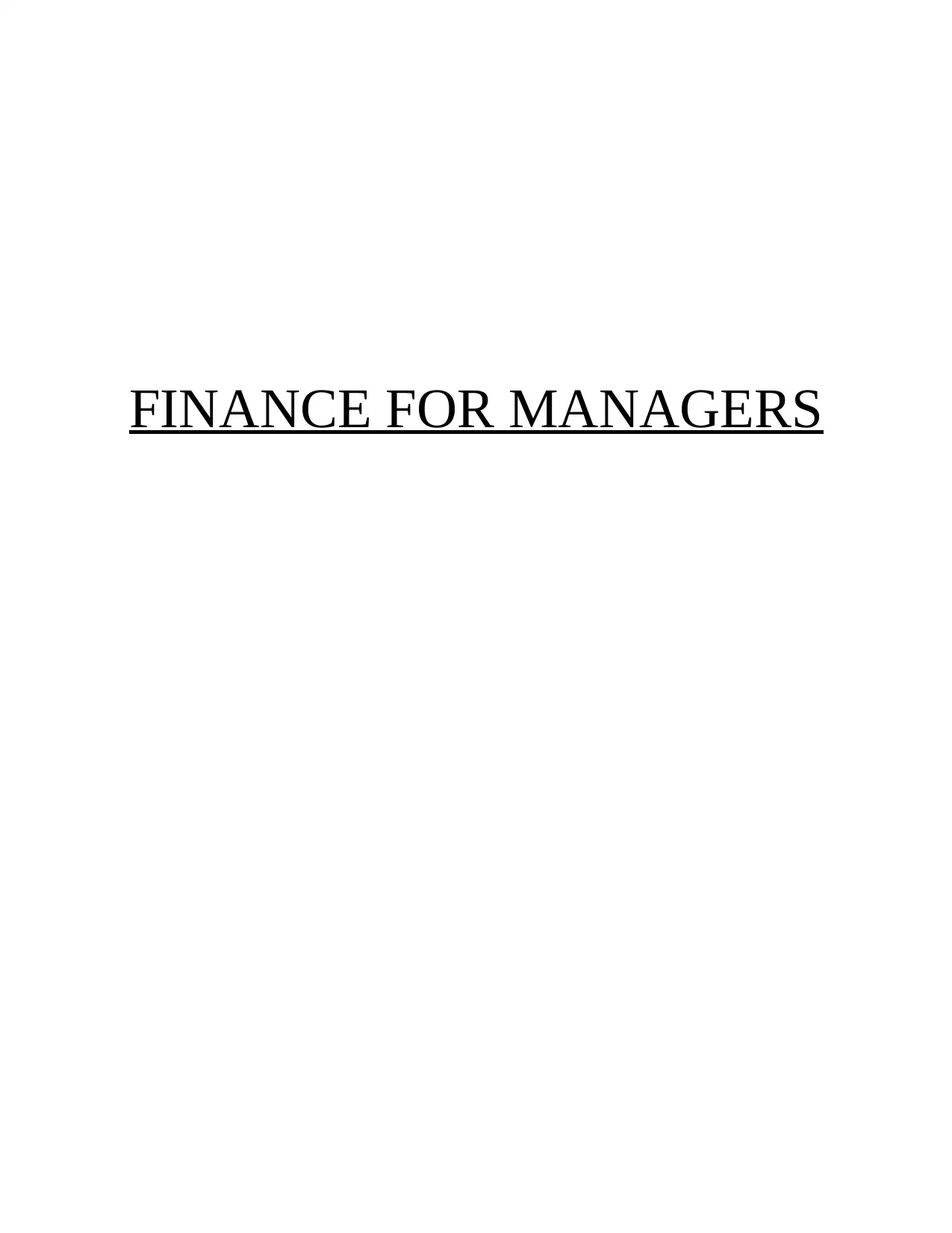
FINANCE FOR MANAGERS
Secure Best Marks with AI Grader
Need help grading? Try our AI Grader for instant feedback on your assignments.

TABLE OF CONTENTS
INTRODUCTION...........................................................................................................................3
ACTIVITY 1...................................................................................................................................3
ACTIVITY 2...................................................................................................................................6
ACTIVITY 3...................................................................................................................................9
ACTIVITY 4.................................................................................................................................11
ACTIVITY 5.................................................................................................................................16
ACTIVITY 6.................................................................................................................................17
CONCLUSION..............................................................................................................................20
REFERENCES..............................................................................................................................21
2
INTRODUCTION...........................................................................................................................3
ACTIVITY 1...................................................................................................................................3
ACTIVITY 2...................................................................................................................................6
ACTIVITY 3...................................................................................................................................9
ACTIVITY 4.................................................................................................................................11
ACTIVITY 5.................................................................................................................................16
ACTIVITY 6.................................................................................................................................17
CONCLUSION..............................................................................................................................20
REFERENCES..............................................................................................................................21
2
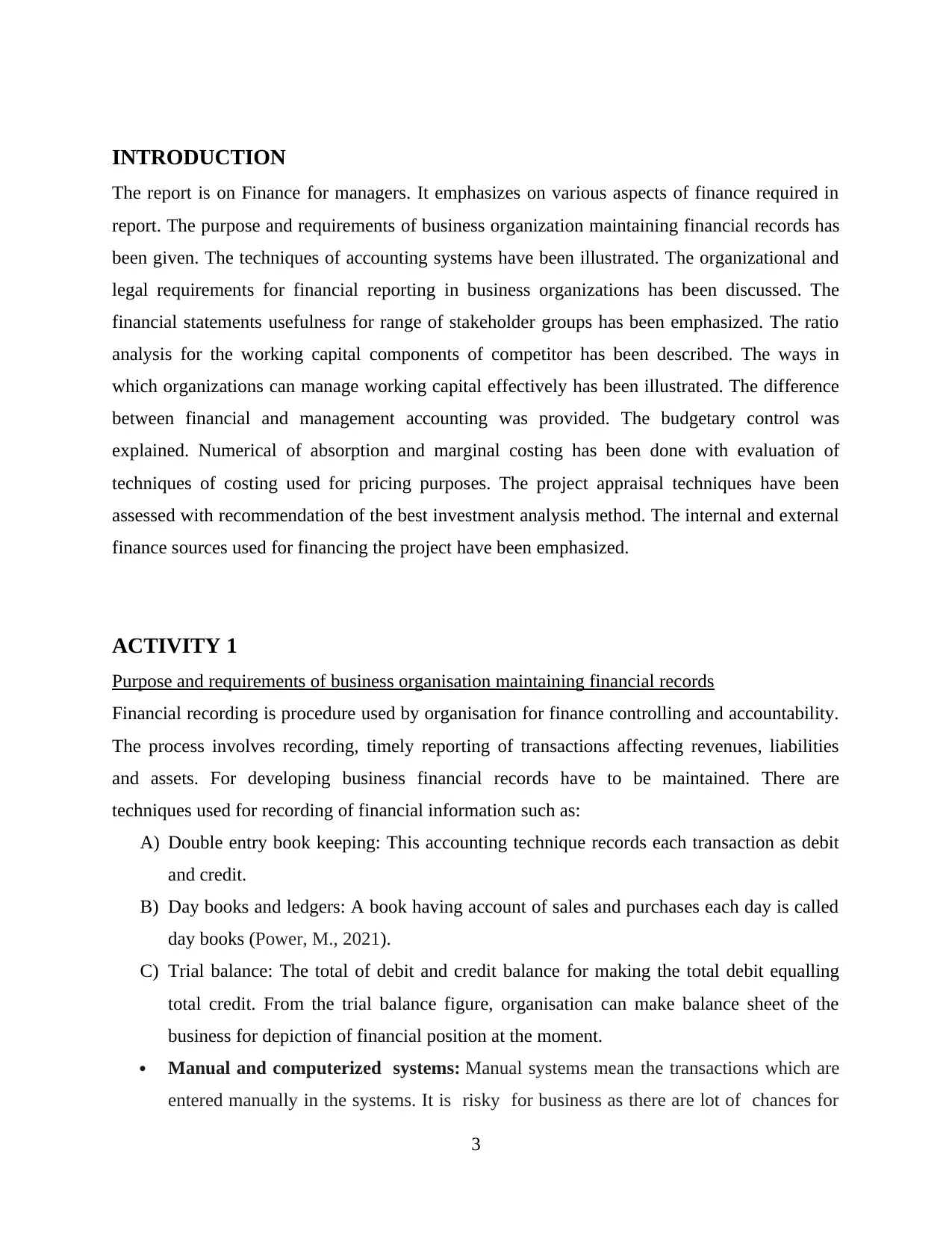
INTRODUCTION
The report is on Finance for managers. It emphasizes on various aspects of finance required in
report. The purpose and requirements of business organization maintaining financial records has
been given. The techniques of accounting systems have been illustrated. The organizational and
legal requirements for financial reporting in business organizations has been discussed. The
financial statements usefulness for range of stakeholder groups has been emphasized. The ratio
analysis for the working capital components of competitor has been described. The ways in
which organizations can manage working capital effectively has been illustrated. The difference
between financial and management accounting was provided. The budgetary control was
explained. Numerical of absorption and marginal costing has been done with evaluation of
techniques of costing used for pricing purposes. The project appraisal techniques have been
assessed with recommendation of the best investment analysis method. The internal and external
finance sources used for financing the project have been emphasized.
ACTIVITY 1
Purpose and requirements of business organisation maintaining financial records
Financial recording is procedure used by organisation for finance controlling and accountability.
The process involves recording, timely reporting of transactions affecting revenues, liabilities
and assets. For developing business financial records have to be maintained. There are
techniques used for recording of financial information such as:
A) Double entry book keeping: This accounting technique records each transaction as debit
and credit.
B) Day books and ledgers: A book having account of sales and purchases each day is called
day books (Power, M., 2021).
C) Trial balance: The total of debit and credit balance for making the total debit equalling
total credit. From the trial balance figure, organisation can make balance sheet of the
business for depiction of financial position at the moment.
Manual and computerized systems: Manual systems mean the transactions which are
entered manually in the systems. It is risky for business as there are lot of chances for
3
The report is on Finance for managers. It emphasizes on various aspects of finance required in
report. The purpose and requirements of business organization maintaining financial records has
been given. The techniques of accounting systems have been illustrated. The organizational and
legal requirements for financial reporting in business organizations has been discussed. The
financial statements usefulness for range of stakeholder groups has been emphasized. The ratio
analysis for the working capital components of competitor has been described. The ways in
which organizations can manage working capital effectively has been illustrated. The difference
between financial and management accounting was provided. The budgetary control was
explained. Numerical of absorption and marginal costing has been done with evaluation of
techniques of costing used for pricing purposes. The project appraisal techniques have been
assessed with recommendation of the best investment analysis method. The internal and external
finance sources used for financing the project have been emphasized.
ACTIVITY 1
Purpose and requirements of business organisation maintaining financial records
Financial recording is procedure used by organisation for finance controlling and accountability.
The process involves recording, timely reporting of transactions affecting revenues, liabilities
and assets. For developing business financial records have to be maintained. There are
techniques used for recording of financial information such as:
A) Double entry book keeping: This accounting technique records each transaction as debit
and credit.
B) Day books and ledgers: A book having account of sales and purchases each day is called
day books (Power, M., 2021).
C) Trial balance: The total of debit and credit balance for making the total debit equalling
total credit. From the trial balance figure, organisation can make balance sheet of the
business for depiction of financial position at the moment.
Manual and computerized systems: Manual systems mean the transactions which are
entered manually in the systems. It is risky for business as there are lot of chances for
3
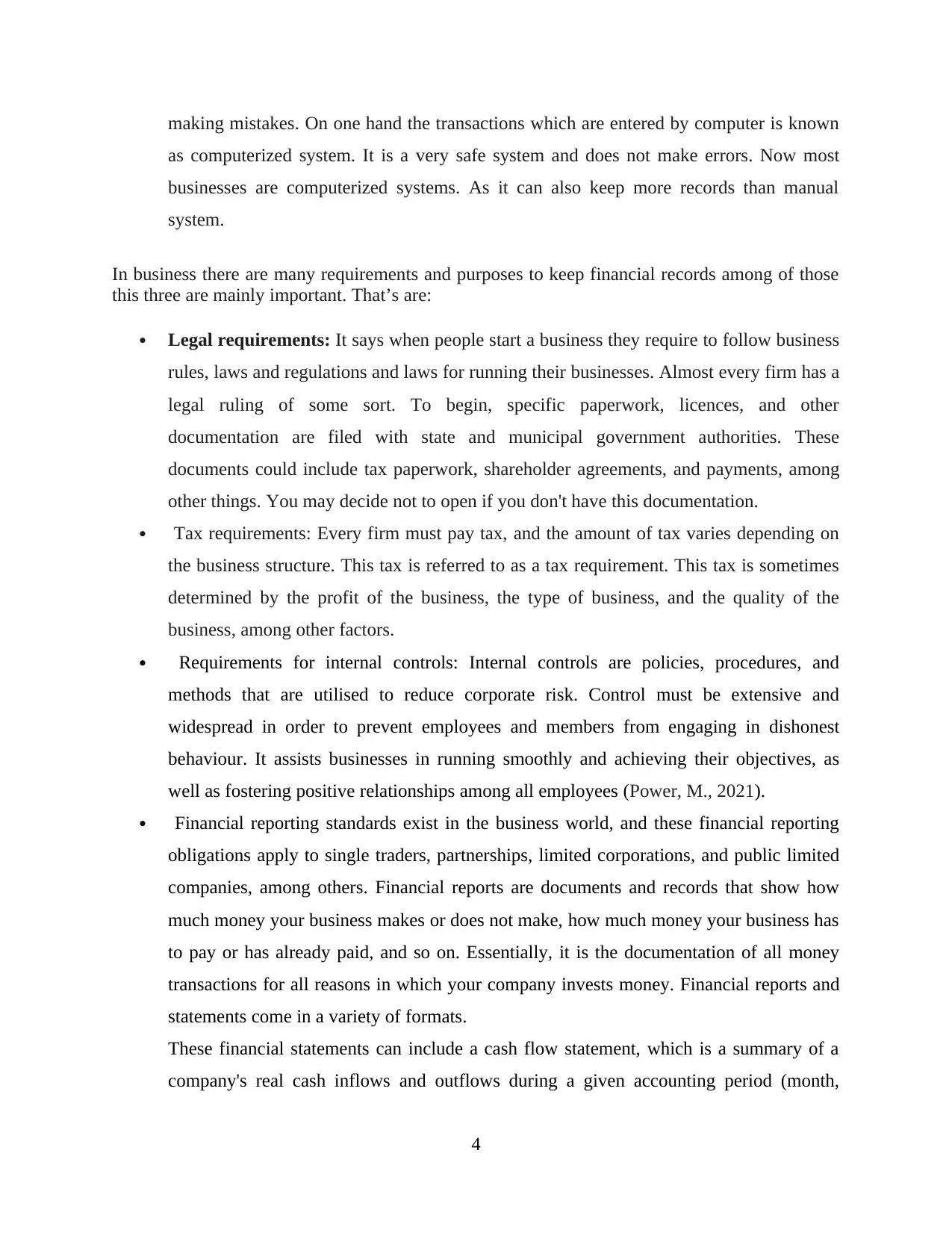
making mistakes. On one hand the transactions which are entered by computer is known
as computerized system. It is a very safe system and does not make errors. Now most
businesses are computerized systems. As it can also keep more records than manual
system.
In business there are many requirements and purposes to keep financial records among of those
this three are mainly important. That’s are:
Legal requirements: It says when people start a business they require to follow business
rules, laws and regulations and laws for running their businesses. Almost every firm has a
legal ruling of some sort. To begin, specific paperwork, licences, and other
documentation are filed with state and municipal government authorities. These
documents could include tax paperwork, shareholder agreements, and payments, among
other things. You may decide not to open if you don't have this documentation.
Tax requirements: Every firm must pay tax, and the amount of tax varies depending on
the business structure. This tax is referred to as a tax requirement. This tax is sometimes
determined by the profit of the business, the type of business, and the quality of the
business, among other factors.
Requirements for internal controls: Internal controls are policies, procedures, and
methods that are utilised to reduce corporate risk. Control must be extensive and
widespread in order to prevent employees and members from engaging in dishonest
behaviour. It assists businesses in running smoothly and achieving their objectives, as
well as fostering positive relationships among all employees (Power, M., 2021).
Financial reporting standards exist in the business world, and these financial reporting
obligations apply to single traders, partnerships, limited corporations, and public limited
companies, among others. Financial reports are documents and records that show how
much money your business makes or does not make, how much money your business has
to pay or has already paid, and so on. Essentially, it is the documentation of all money
transactions for all reasons in which your company invests money. Financial reports and
statements come in a variety of formats.
These financial statements can include a cash flow statement, which is a summary of a
company's real cash inflows and outflows during a given accounting period (month,
4
as computerized system. It is a very safe system and does not make errors. Now most
businesses are computerized systems. As it can also keep more records than manual
system.
In business there are many requirements and purposes to keep financial records among of those
this three are mainly important. That’s are:
Legal requirements: It says when people start a business they require to follow business
rules, laws and regulations and laws for running their businesses. Almost every firm has a
legal ruling of some sort. To begin, specific paperwork, licences, and other
documentation are filed with state and municipal government authorities. These
documents could include tax paperwork, shareholder agreements, and payments, among
other things. You may decide not to open if you don't have this documentation.
Tax requirements: Every firm must pay tax, and the amount of tax varies depending on
the business structure. This tax is referred to as a tax requirement. This tax is sometimes
determined by the profit of the business, the type of business, and the quality of the
business, among other factors.
Requirements for internal controls: Internal controls are policies, procedures, and
methods that are utilised to reduce corporate risk. Control must be extensive and
widespread in order to prevent employees and members from engaging in dishonest
behaviour. It assists businesses in running smoothly and achieving their objectives, as
well as fostering positive relationships among all employees (Power, M., 2021).
Financial reporting standards exist in the business world, and these financial reporting
obligations apply to single traders, partnerships, limited corporations, and public limited
companies, among others. Financial reports are documents and records that show how
much money your business makes or does not make, how much money your business has
to pay or has already paid, and so on. Essentially, it is the documentation of all money
transactions for all reasons in which your company invests money. Financial reports and
statements come in a variety of formats.
These financial statements can include a cash flow statement, which is a summary of a
company's real cash inflows and outflows during a given accounting period (month,
4
Paraphrase This Document
Need a fresh take? Get an instant paraphrase of this document with our AI Paraphraser
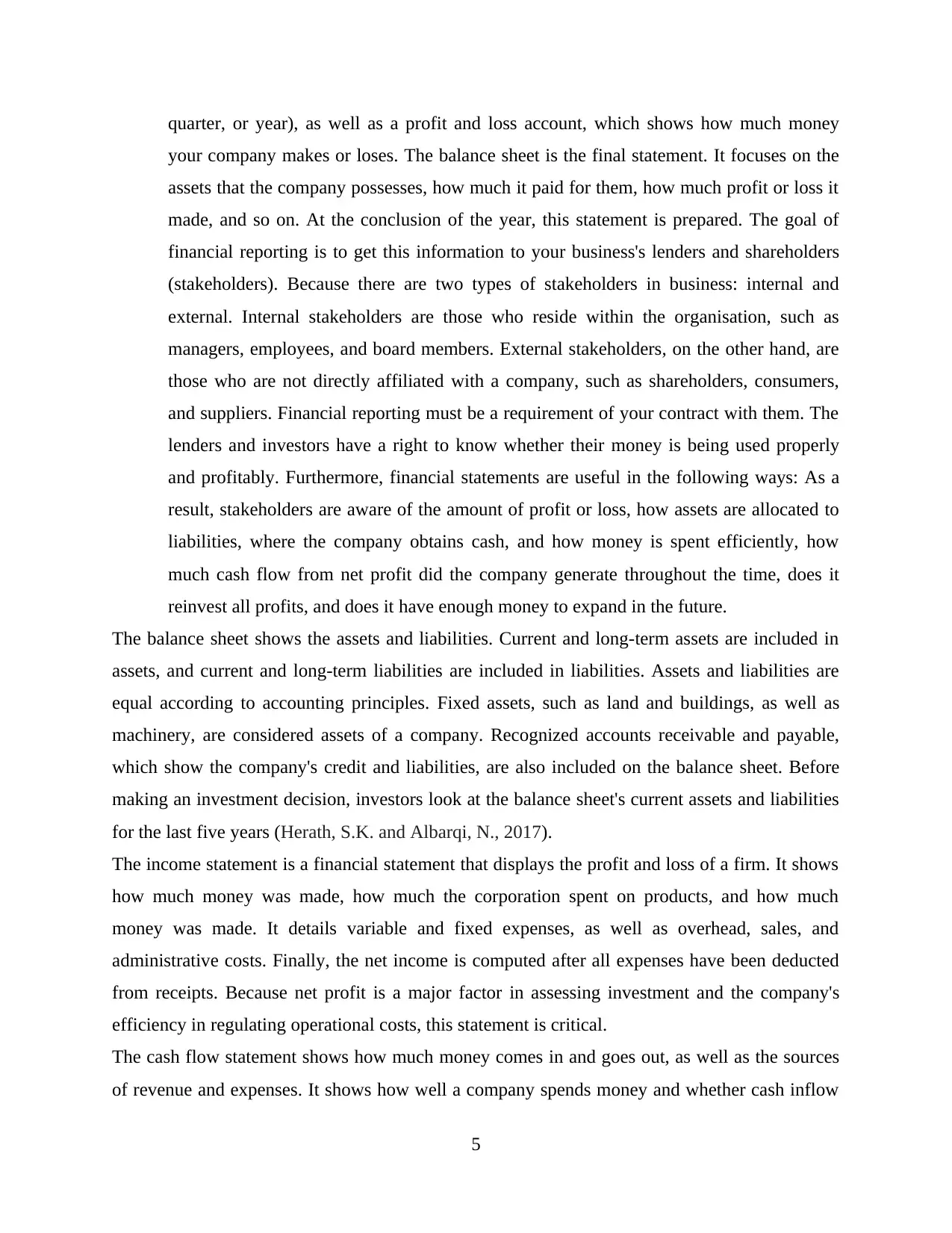
quarter, or year), as well as a profit and loss account, which shows how much money
your company makes or loses. The balance sheet is the final statement. It focuses on the
assets that the company possesses, how much it paid for them, how much profit or loss it
made, and so on. At the conclusion of the year, this statement is prepared. The goal of
financial reporting is to get this information to your business's lenders and shareholders
(stakeholders). Because there are two types of stakeholders in business: internal and
external. Internal stakeholders are those who reside within the organisation, such as
managers, employees, and board members. External stakeholders, on the other hand, are
those who are not directly affiliated with a company, such as shareholders, consumers,
and suppliers. Financial reporting must be a requirement of your contract with them. The
lenders and investors have a right to know whether their money is being used properly
and profitably. Furthermore, financial statements are useful in the following ways: As a
result, stakeholders are aware of the amount of profit or loss, how assets are allocated to
liabilities, where the company obtains cash, and how money is spent efficiently, how
much cash flow from net profit did the company generate throughout the time, does it
reinvest all profits, and does it have enough money to expand in the future.
The balance sheet shows the assets and liabilities. Current and long-term assets are included in
assets, and current and long-term liabilities are included in liabilities. Assets and liabilities are
equal according to accounting principles. Fixed assets, such as land and buildings, as well as
machinery, are considered assets of a company. Recognized accounts receivable and payable,
which show the company's credit and liabilities, are also included on the balance sheet. Before
making an investment decision, investors look at the balance sheet's current assets and liabilities
for the last five years (Herath, S.K. and Albarqi, N., 2017).
The income statement is a financial statement that displays the profit and loss of a firm. It shows
how much money was made, how much the corporation spent on products, and how much
money was made. It details variable and fixed expenses, as well as overhead, sales, and
administrative costs. Finally, the net income is computed after all expenses have been deducted
from receipts. Because net profit is a major factor in assessing investment and the company's
efficiency in regulating operational costs, this statement is critical.
The cash flow statement shows how much money comes in and goes out, as well as the sources
of revenue and expenses. It shows how well a company spends money and whether cash inflow
5
your company makes or loses. The balance sheet is the final statement. It focuses on the
assets that the company possesses, how much it paid for them, how much profit or loss it
made, and so on. At the conclusion of the year, this statement is prepared. The goal of
financial reporting is to get this information to your business's lenders and shareholders
(stakeholders). Because there are two types of stakeholders in business: internal and
external. Internal stakeholders are those who reside within the organisation, such as
managers, employees, and board members. External stakeholders, on the other hand, are
those who are not directly affiliated with a company, such as shareholders, consumers,
and suppliers. Financial reporting must be a requirement of your contract with them. The
lenders and investors have a right to know whether their money is being used properly
and profitably. Furthermore, financial statements are useful in the following ways: As a
result, stakeholders are aware of the amount of profit or loss, how assets are allocated to
liabilities, where the company obtains cash, and how money is spent efficiently, how
much cash flow from net profit did the company generate throughout the time, does it
reinvest all profits, and does it have enough money to expand in the future.
The balance sheet shows the assets and liabilities. Current and long-term assets are included in
assets, and current and long-term liabilities are included in liabilities. Assets and liabilities are
equal according to accounting principles. Fixed assets, such as land and buildings, as well as
machinery, are considered assets of a company. Recognized accounts receivable and payable,
which show the company's credit and liabilities, are also included on the balance sheet. Before
making an investment decision, investors look at the balance sheet's current assets and liabilities
for the last five years (Herath, S.K. and Albarqi, N., 2017).
The income statement is a financial statement that displays the profit and loss of a firm. It shows
how much money was made, how much the corporation spent on products, and how much
money was made. It details variable and fixed expenses, as well as overhead, sales, and
administrative costs. Finally, the net income is computed after all expenses have been deducted
from receipts. Because net profit is a major factor in assessing investment and the company's
efficiency in regulating operational costs, this statement is critical.
The cash flow statement shows how much money comes in and goes out, as well as the sources
of revenue and expenses. It shows how well a company spends money and whether cash inflow
5
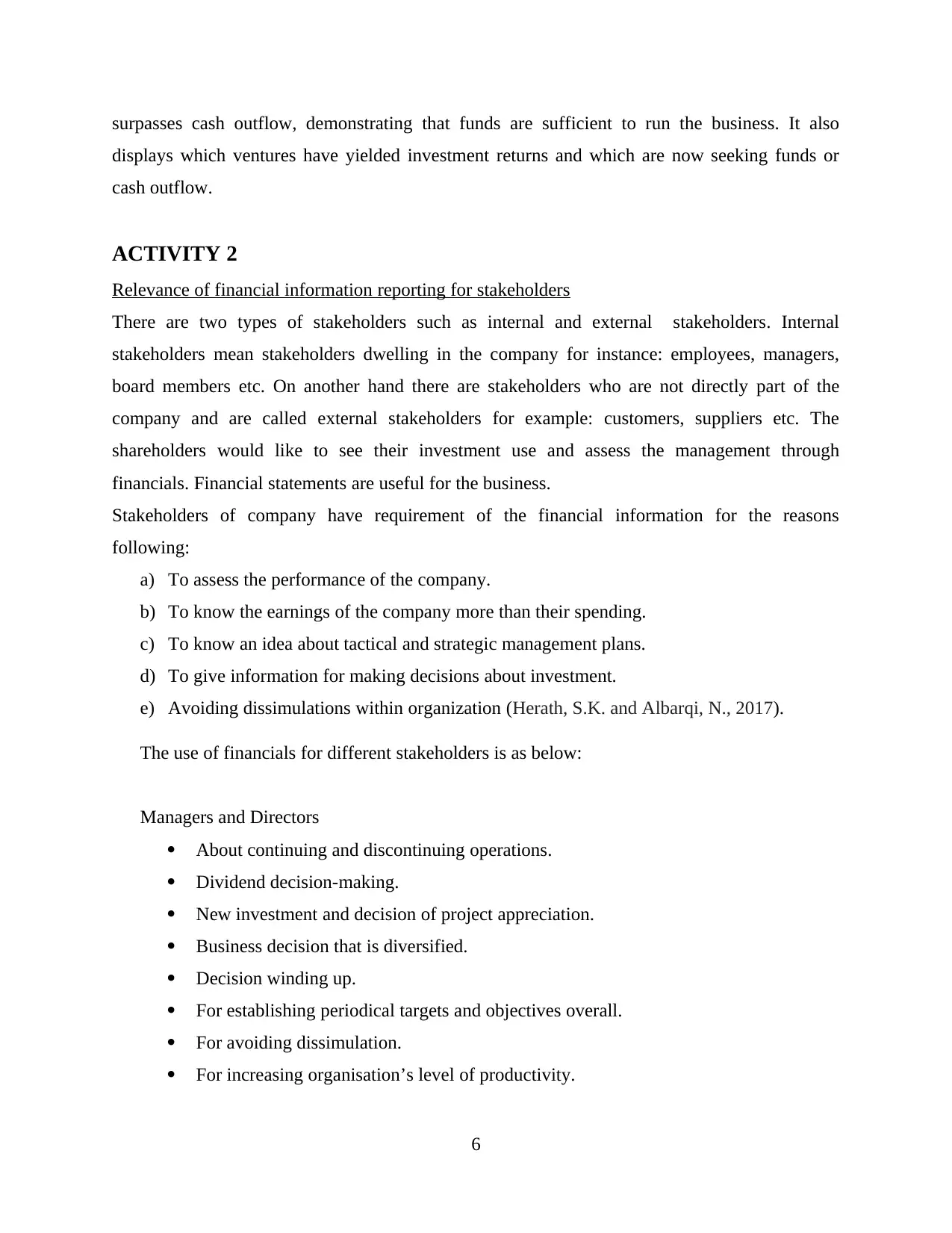
surpasses cash outflow, demonstrating that funds are sufficient to run the business. It also
displays which ventures have yielded investment returns and which are now seeking funds or
cash outflow.
ACTIVITY 2
Relevance of financial information reporting for stakeholders
There are two types of stakeholders such as internal and external stakeholders. Internal
stakeholders mean stakeholders dwelling in the company for instance: employees, managers,
board members etc. On another hand there are stakeholders who are not directly part of the
company and are called external stakeholders for example: customers, suppliers etc. The
shareholders would like to see their investment use and assess the management through
financials. Financial statements are useful for the business.
Stakeholders of company have requirement of the financial information for the reasons
following:
a) To assess the performance of the company.
b) To know the earnings of the company more than their spending.
c) To know an idea about tactical and strategic management plans.
d) To give information for making decisions about investment.
e) Avoiding dissimulations within organization (Herath, S.K. and Albarqi, N., 2017).
The use of financials for different stakeholders is as below:
Managers and Directors
About continuing and discontinuing operations.
Dividend decision-making.
New investment and decision of project appreciation.
Business decision that is diversified.
Decision winding up.
For establishing periodical targets and objectives overall.
For avoiding dissimulation.
For increasing organisation’s level of productivity.
6
displays which ventures have yielded investment returns and which are now seeking funds or
cash outflow.
ACTIVITY 2
Relevance of financial information reporting for stakeholders
There are two types of stakeholders such as internal and external stakeholders. Internal
stakeholders mean stakeholders dwelling in the company for instance: employees, managers,
board members etc. On another hand there are stakeholders who are not directly part of the
company and are called external stakeholders for example: customers, suppliers etc. The
shareholders would like to see their investment use and assess the management through
financials. Financial statements are useful for the business.
Stakeholders of company have requirement of the financial information for the reasons
following:
a) To assess the performance of the company.
b) To know the earnings of the company more than their spending.
c) To know an idea about tactical and strategic management plans.
d) To give information for making decisions about investment.
e) Avoiding dissimulations within organization (Herath, S.K. and Albarqi, N., 2017).
The use of financials for different stakeholders is as below:
Managers and Directors
About continuing and discontinuing operations.
Dividend decision-making.
New investment and decision of project appreciation.
Business decision that is diversified.
Decision winding up.
For establishing periodical targets and objectives overall.
For avoiding dissimulation.
For increasing organisation’s level of productivity.
6

Shareholders
For determination as to whether investment shall be sold, halted or buying shares of
the organization.
For deciding the fairness of investments’ return.
For determining the organisation’s going concern.
For obtaining knowledge widely about activities of organization.
For comparison of investing and benefits with competitive industries and
organisations.
Employees
For knowing the profitability and stableness of the organization.
For knowing about salary, benefits of retirement and opportunities of employment in
organization.
For ensuring job security with current organization.
For ensuring the fairness of wages and earnings obtained from the company.
For having a view which is clear of other operations of organization.
Suppliers
For ensuring the supply of payments which shall be received on due.
For ensuring the customers’ stability.
For having knowledge about suppliers of organization and other products.
For comparison of transaction with existing and other companies (Lambovska, M.,
Rajnoha, R. and Dobrovič, J., 2019).
For finding competitive suppliers and contribution towards organization.
For finding opportunities for supplying more.
Government
For collection of accurate tax and amount from organisations on due dates.
For providing government benefit for improving their business.
For obtaining non-financial and financial help for government development projects.
7
For determination as to whether investment shall be sold, halted or buying shares of
the organization.
For deciding the fairness of investments’ return.
For determining the organisation’s going concern.
For obtaining knowledge widely about activities of organization.
For comparison of investing and benefits with competitive industries and
organisations.
Employees
For knowing the profitability and stableness of the organization.
For knowing about salary, benefits of retirement and opportunities of employment in
organization.
For ensuring job security with current organization.
For ensuring the fairness of wages and earnings obtained from the company.
For having a view which is clear of other operations of organization.
Suppliers
For ensuring the supply of payments which shall be received on due.
For ensuring the customers’ stability.
For having knowledge about suppliers of organization and other products.
For comparison of transaction with existing and other companies (Lambovska, M.,
Rajnoha, R. and Dobrovič, J., 2019).
For finding competitive suppliers and contribution towards organization.
For finding opportunities for supplying more.
Government
For collection of accurate tax and amount from organisations on due dates.
For providing government benefit for improving their business.
For obtaining non-financial and financial help for government development projects.
7
Secure Best Marks with AI Grader
Need help grading? Try our AI Grader for instant feedback on your assignments.

For ensuring organisations overseeing the employees in reasonable way.
For ensuring compliance of organisations with rules and regulations of government
and acts government has established.
Consumers
For having knowledge about products’ cost structure that the organization has been
producing.
For ensuring organisation’s stability.
For knowing about profitability of organization, as profitability helps to know about
product improvements, best customer service and strategic implications that are of
low price.
For knowing about CSR programs organization has conducted.
Public
For being aware about substantial contribution of organization towards society.
For knowing about opportunities for linking with organization (Lambovska, M.,
Rajnoha, R. and Dobrovič, J., 2019).
For knowing about CSR contribution towards country.
To make conscious activities that can be affected to nature’s interest and of the
country.
ACTIVITY 3
Ratio analysis of Competitor Alpha Limited
2019 2020
8
For ensuring compliance of organisations with rules and regulations of government
and acts government has established.
Consumers
For having knowledge about products’ cost structure that the organization has been
producing.
For ensuring organisation’s stability.
For knowing about profitability of organization, as profitability helps to know about
product improvements, best customer service and strategic implications that are of
low price.
For knowing about CSR programs organization has conducted.
Public
For being aware about substantial contribution of organization towards society.
For knowing about opportunities for linking with organization (Lambovska, M.,
Rajnoha, R. and Dobrovič, J., 2019).
For knowing about CSR contribution towards country.
To make conscious activities that can be affected to nature’s interest and of the
country.
ACTIVITY 3
Ratio analysis of Competitor Alpha Limited
2019 2020
8

Current Ratio=Current
Assets/Current Liabilities
757.50/322.50=2.34 1035/1110=0.93
Average receivable
days=Receivables/Sales*365
450/2400*365=68.43 600/3000*365=73
Current ratio
It's a liquidity ratio showing the current obligations which are current and company’s assets. It
demonstrate that if an organisation can satisfy its obligations of short-term in a year while also
increasing current assets for offsetting current liabilities and debt, results in working capital.
Current assets are ones which have to be used or sold in a year for keeping operations taking
place in smooth manner. Cash, accounts receivable, stock inventory stock are a few examples.
Accounts payables, short-term loans are instances of current liabilities which have to be paid off
in a year (Mack, S. and Goretzki, L., 2017).
Current ratio of Alpha Limited has been close to 1 in 2019, which is a good sign for the
liquidity of organisation. This gives indication that current assets of the company are almost
equal to the current liabilities.
Average receivable days
The average receivable days refer to time taken for collection of receivables from owers. The
quicker a loan gets repaid, more cash becomes available for working capital and also payback of
debt. The denominator of sales is utilised for calculating the ratio since the rate of recovery of
receivables depends on generated sales. As sales is calculated yearly, the numerator’s product
and the sales’ product gets multiplied by 365.
Alpha Limited receivable days have decreased which is a good sign for the company and its
working capital.
Accounts payable period
Speaking of account payable, it can be said that organisation should be using the period of
period for its advantage. It may assist in increasing operations, for opening up branches that are
9
Assets/Current Liabilities
757.50/322.50=2.34 1035/1110=0.93
Average receivable
days=Receivables/Sales*365
450/2400*365=68.43 600/3000*365=73
Current ratio
It's a liquidity ratio showing the current obligations which are current and company’s assets. It
demonstrate that if an organisation can satisfy its obligations of short-term in a year while also
increasing current assets for offsetting current liabilities and debt, results in working capital.
Current assets are ones which have to be used or sold in a year for keeping operations taking
place in smooth manner. Cash, accounts receivable, stock inventory stock are a few examples.
Accounts payables, short-term loans are instances of current liabilities which have to be paid off
in a year (Mack, S. and Goretzki, L., 2017).
Current ratio of Alpha Limited has been close to 1 in 2019, which is a good sign for the
liquidity of organisation. This gives indication that current assets of the company are almost
equal to the current liabilities.
Average receivable days
The average receivable days refer to time taken for collection of receivables from owers. The
quicker a loan gets repaid, more cash becomes available for working capital and also payback of
debt. The denominator of sales is utilised for calculating the ratio since the rate of recovery of
receivables depends on generated sales. As sales is calculated yearly, the numerator’s product
and the sales’ product gets multiplied by 365.
Alpha Limited receivable days have decreased which is a good sign for the company and its
working capital.
Accounts payable period
Speaking of account payable, it can be said that organisation should be using the period of
period for its advantage. It may assist in increasing operations, for opening up branches that are
9
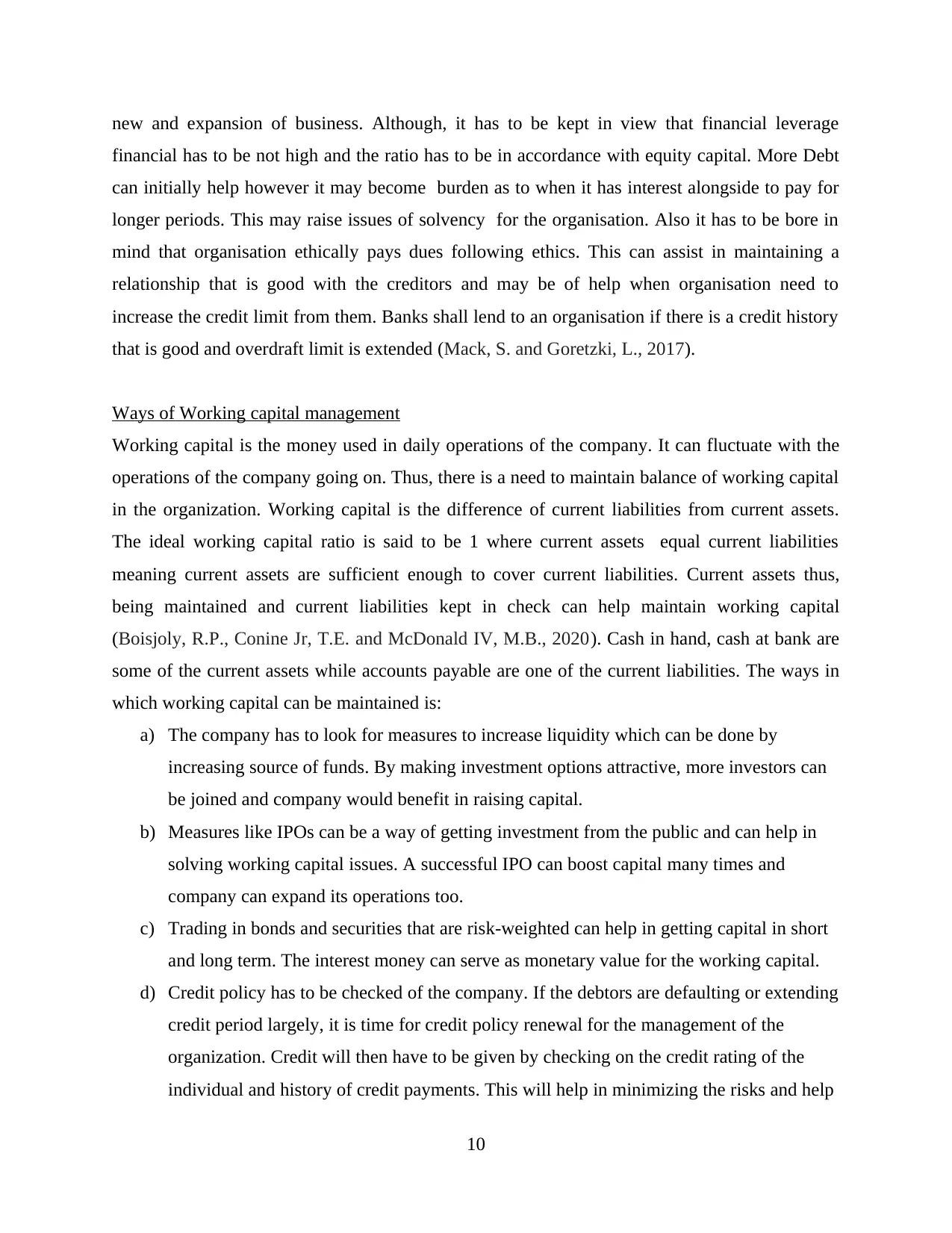
new and expansion of business. Although, it has to be kept in view that financial leverage
financial has to be not high and the ratio has to be in accordance with equity capital. More Debt
can initially help however it may become burden as to when it has interest alongside to pay for
longer periods. This may raise issues of solvency for the organisation. Also it has to be bore in
mind that organisation ethically pays dues following ethics. This can assist in maintaining a
relationship that is good with the creditors and may be of help when organisation need to
increase the credit limit from them. Banks shall lend to an organisation if there is a credit history
that is good and overdraft limit is extended (Mack, S. and Goretzki, L., 2017).
Ways of Working capital management
Working capital is the money used in daily operations of the company. It can fluctuate with the
operations of the company going on. Thus, there is a need to maintain balance of working capital
in the organization. Working capital is the difference of current liabilities from current assets.
The ideal working capital ratio is said to be 1 where current assets equal current liabilities
meaning current assets are sufficient enough to cover current liabilities. Current assets thus,
being maintained and current liabilities kept in check can help maintain working capital
(Boisjoly, R.P., Conine Jr, T.E. and McDonald IV, M.B., 2020). Cash in hand, cash at bank are
some of the current assets while accounts payable are one of the current liabilities. The ways in
which working capital can be maintained is:
a) The company has to look for measures to increase liquidity which can be done by
increasing source of funds. By making investment options attractive, more investors can
be joined and company would benefit in raising capital.
b) Measures like IPOs can be a way of getting investment from the public and can help in
solving working capital issues. A successful IPO can boost capital many times and
company can expand its operations too.
c) Trading in bonds and securities that are risk-weighted can help in getting capital in short
and long term. The interest money can serve as monetary value for the working capital.
d) Credit policy has to be checked of the company. If the debtors are defaulting or extending
credit period largely, it is time for credit policy renewal for the management of the
organization. Credit will then have to be given by checking on the credit rating of the
individual and history of credit payments. This will help in minimizing the risks and help
10
financial has to be not high and the ratio has to be in accordance with equity capital. More Debt
can initially help however it may become burden as to when it has interest alongside to pay for
longer periods. This may raise issues of solvency for the organisation. Also it has to be bore in
mind that organisation ethically pays dues following ethics. This can assist in maintaining a
relationship that is good with the creditors and may be of help when organisation need to
increase the credit limit from them. Banks shall lend to an organisation if there is a credit history
that is good and overdraft limit is extended (Mack, S. and Goretzki, L., 2017).
Ways of Working capital management
Working capital is the money used in daily operations of the company. It can fluctuate with the
operations of the company going on. Thus, there is a need to maintain balance of working capital
in the organization. Working capital is the difference of current liabilities from current assets.
The ideal working capital ratio is said to be 1 where current assets equal current liabilities
meaning current assets are sufficient enough to cover current liabilities. Current assets thus,
being maintained and current liabilities kept in check can help maintain working capital
(Boisjoly, R.P., Conine Jr, T.E. and McDonald IV, M.B., 2020). Cash in hand, cash at bank are
some of the current assets while accounts payable are one of the current liabilities. The ways in
which working capital can be maintained is:
a) The company has to look for measures to increase liquidity which can be done by
increasing source of funds. By making investment options attractive, more investors can
be joined and company would benefit in raising capital.
b) Measures like IPOs can be a way of getting investment from the public and can help in
solving working capital issues. A successful IPO can boost capital many times and
company can expand its operations too.
c) Trading in bonds and securities that are risk-weighted can help in getting capital in short
and long term. The interest money can serve as monetary value for the working capital.
d) Credit policy has to be checked of the company. If the debtors are defaulting or extending
credit period largely, it is time for credit policy renewal for the management of the
organization. Credit will then have to be given by checking on the credit rating of the
individual and history of credit payments. This will help in minimizing the risks and help
10
Paraphrase This Document
Need a fresh take? Get an instant paraphrase of this document with our AI Paraphraser

to get credit back on time thus, it will help in the working capital get increased and also
receive money with interest to help further in daily operations of the company.
e) Company taking credit for own operations has to use the credit period judiciously as
working capital. Credit taken has to be for a term that is enough for the duration of
project’s operations. This way, project reaping benefits in monetary value can be paid
back as credit repayment and rest profits can be used for investors and organization. A
small credit period can affect the working capital and is not appropriate. The company
can earn profits and also repay the creditors back on time, with the right deal.
f) The company has to maintain the right financial leverage of debt and equity. Piling debt
can be a cause of concern to repay later. Thus, focusing on equity increase can help
maintain the solvency and working capital balance too of the organization.
g) Stock control measures of inventory have to be taken in a way which improves working
capital condition. Inventory if bought in excess, can be cause of monetary concern for the
company. There are costs of storing inventory and also if there is a damage, company has
to bear the loss. Getting right amount of inventory using method of Economic Order
Quantity can help in maintaining the stock with getting just the right amount of inventory
needed and thus saving on the additional costs of storage which can decrease cash in
current assets. This will increase working capital as inventories add to current assets
without bearing losses. Company can also go for the Just in Time Inventory approach as
per the requirement (Boisjoly and et.al.,2020).
h) Overdrafts taken from bank can help in increase for working capital. Company’s
management has to get in touch with the bank in this aspect so, credit limit is increased
and also there is sufficient time period in which company can repay the same through
profits earned by the projects.
ACTIVITY 4
Difference between financial and management accounting
Financial accounting concerns with financial transaction and statement which have taken
place already. It implies information gathering about transactions of business. For instance:
loss and gain. The process is controlled by manager of finance.
11
receive money with interest to help further in daily operations of the company.
e) Company taking credit for own operations has to use the credit period judiciously as
working capital. Credit taken has to be for a term that is enough for the duration of
project’s operations. This way, project reaping benefits in monetary value can be paid
back as credit repayment and rest profits can be used for investors and organization. A
small credit period can affect the working capital and is not appropriate. The company
can earn profits and also repay the creditors back on time, with the right deal.
f) The company has to maintain the right financial leverage of debt and equity. Piling debt
can be a cause of concern to repay later. Thus, focusing on equity increase can help
maintain the solvency and working capital balance too of the organization.
g) Stock control measures of inventory have to be taken in a way which improves working
capital condition. Inventory if bought in excess, can be cause of monetary concern for the
company. There are costs of storing inventory and also if there is a damage, company has
to bear the loss. Getting right amount of inventory using method of Economic Order
Quantity can help in maintaining the stock with getting just the right amount of inventory
needed and thus saving on the additional costs of storage which can decrease cash in
current assets. This will increase working capital as inventories add to current assets
without bearing losses. Company can also go for the Just in Time Inventory approach as
per the requirement (Boisjoly and et.al.,2020).
h) Overdrafts taken from bank can help in increase for working capital. Company’s
management has to get in touch with the bank in this aspect so, credit limit is increased
and also there is sufficient time period in which company can repay the same through
profits earned by the projects.
ACTIVITY 4
Difference between financial and management accounting
Financial accounting concerns with financial transaction and statement which have taken
place already. It implies information gathering about transactions of business. For instance:
loss and gain. The process is controlled by manager of finance.
11

Management accounting is providing organisation’s management with recommendations
that are accounting information based, in order for assisting in day-to-day decision-making
and in planning of long term. The process is controlled by finance manager. Financial and
management accounting gives information in two different user groups. Financial accounting
provides information for accounting data’s external users of data of accounting like creditors
and investors. On other hand, management accounting provide information for accounting
data’s internal users. Internal users have inclusion of managers, executives and employees of
the company. Financial accounting reports on information which is historical. Information is
regularly reported. It is broken in quarterly, annual and monthly periods of reporting. On
another aspect, information of management accounting is reported on continuous basis.
Internal users need evaluation of present, past and future information potential in order for
making decisions. Thus, these users need information on continuous basis for making
decisions which are appropriate. These two accounting systems have their own importance in
business. Without these businesses cannot operate smoothly and make profits (Nastiti,
P.K.Y., Atahau, A.D.R. and Supramono, S., 2019).
Financial accounting presents reports annually while management accounting reports are of
long and short durations. Financial accounting covers entire organization whereas
management accounting are prepared for organization as well as segments.
It emphasizes facts’ accuracy while management accounting require quick and on time
reporting of facts if they are less accurate.
Focus- Financial accounting emphasizes accounting data’s external use and main focus of
this form of accounting is on balance sheet preparation and resources and obligations’ state.
The purpose of management accounting reports and collects information which is relevant
for making of decisions for ensuring firm’s resources being used optimally.
Principles- The financial accounting adherence is for the generally accepted accounting
principles. This gives introduction to consistency and data meaningfulness from view point
of investors. Inter firm comparisons of performance and performance trend is analyzed over
period of time when some set of GAAP is followed by firms. Management accounting is not
based on the set of rules that are accepted. Each enterprise, depends on requirement for facts,
evolving own principles and procedures for preparation of reports for internal uses. The
information has to be of relevance and help management in decision-making.
12
that are accounting information based, in order for assisting in day-to-day decision-making
and in planning of long term. The process is controlled by finance manager. Financial and
management accounting gives information in two different user groups. Financial accounting
provides information for accounting data’s external users of data of accounting like creditors
and investors. On other hand, management accounting provide information for accounting
data’s internal users. Internal users have inclusion of managers, executives and employees of
the company. Financial accounting reports on information which is historical. Information is
regularly reported. It is broken in quarterly, annual and monthly periods of reporting. On
another aspect, information of management accounting is reported on continuous basis.
Internal users need evaluation of present, past and future information potential in order for
making decisions. Thus, these users need information on continuous basis for making
decisions which are appropriate. These two accounting systems have their own importance in
business. Without these businesses cannot operate smoothly and make profits (Nastiti,
P.K.Y., Atahau, A.D.R. and Supramono, S., 2019).
Financial accounting presents reports annually while management accounting reports are of
long and short durations. Financial accounting covers entire organization whereas
management accounting are prepared for organization as well as segments.
It emphasizes facts’ accuracy while management accounting require quick and on time
reporting of facts if they are less accurate.
Focus- Financial accounting emphasizes accounting data’s external use and main focus of
this form of accounting is on balance sheet preparation and resources and obligations’ state.
The purpose of management accounting reports and collects information which is relevant
for making of decisions for ensuring firm’s resources being used optimally.
Principles- The financial accounting adherence is for the generally accepted accounting
principles. This gives introduction to consistency and data meaningfulness from view point
of investors. Inter firm comparisons of performance and performance trend is analyzed over
period of time when some set of GAAP is followed by firms. Management accounting is not
based on the set of rules that are accepted. Each enterprise, depends on requirement for facts,
evolving own principles and procedures for preparation of reports for internal uses. The
information has to be of relevance and help management in decision-making.
12
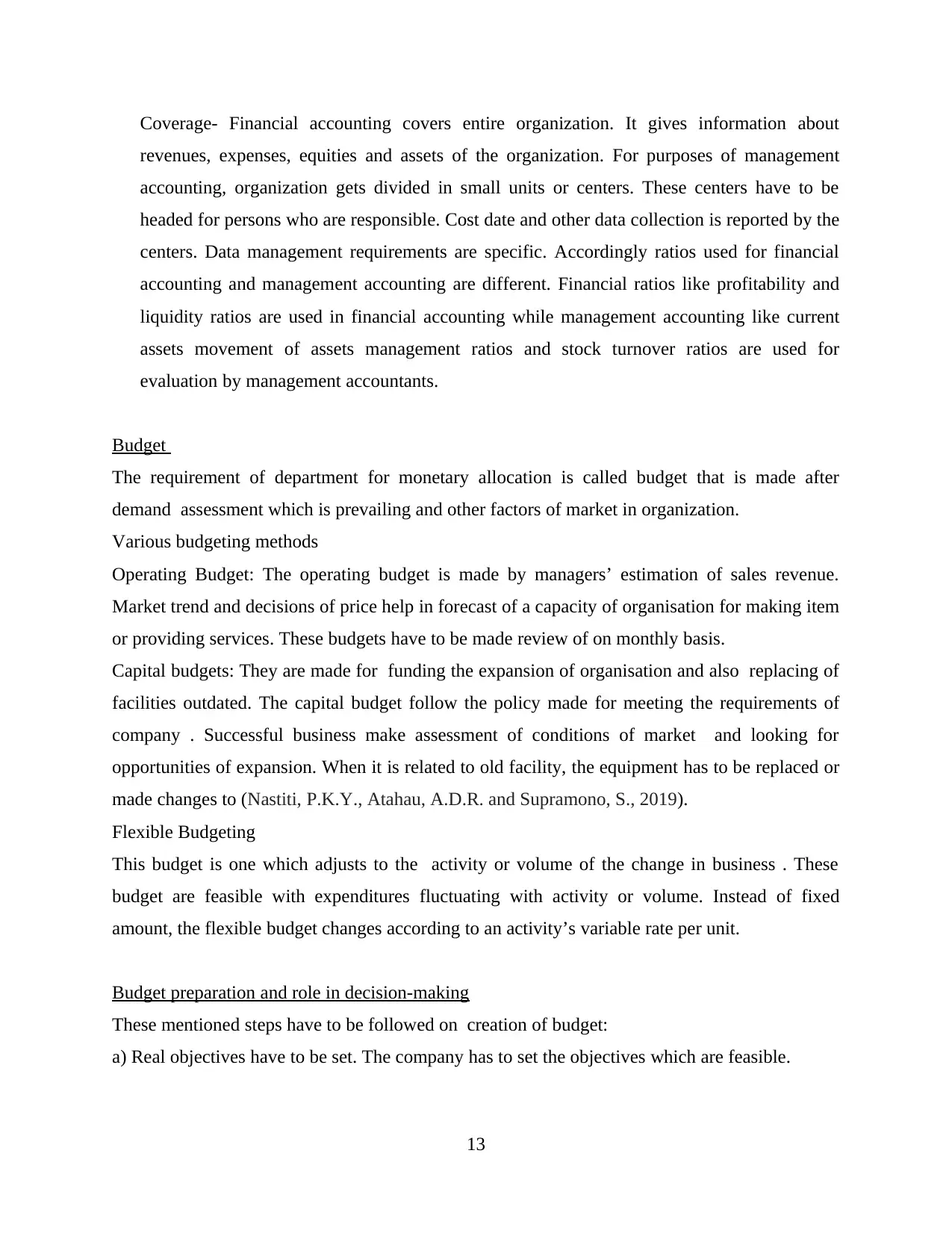
Coverage- Financial accounting covers entire organization. It gives information about
revenues, expenses, equities and assets of the organization. For purposes of management
accounting, organization gets divided in small units or centers. These centers have to be
headed for persons who are responsible. Cost date and other data collection is reported by the
centers. Data management requirements are specific. Accordingly ratios used for financial
accounting and management accounting are different. Financial ratios like profitability and
liquidity ratios are used in financial accounting while management accounting like current
assets movement of assets management ratios and stock turnover ratios are used for
evaluation by management accountants.
Budget
The requirement of department for monetary allocation is called budget that is made after
demand assessment which is prevailing and other factors of market in organization.
Various budgeting methods
Operating Budget: The operating budget is made by managers’ estimation of sales revenue.
Market trend and decisions of price help in forecast of a capacity of organisation for making item
or providing services. These budgets have to be made review of on monthly basis.
Capital budgets: They are made for funding the expansion of organisation and also replacing of
facilities outdated. The capital budget follow the policy made for meeting the requirements of
company . Successful business make assessment of conditions of market and looking for
opportunities of expansion. When it is related to old facility, the equipment has to be replaced or
made changes to (Nastiti, P.K.Y., Atahau, A.D.R. and Supramono, S., 2019).
Flexible Budgeting
This budget is one which adjusts to the activity or volume of the change in business . These
budget are feasible with expenditures fluctuating with activity or volume. Instead of fixed
amount, the flexible budget changes according to an activity’s variable rate per unit.
Budget preparation and role in decision-making
These mentioned steps have to be followed on creation of budget:
a) Real objectives have to be set. The company has to set the objectives which are feasible.
13
revenues, expenses, equities and assets of the organization. For purposes of management
accounting, organization gets divided in small units or centers. These centers have to be
headed for persons who are responsible. Cost date and other data collection is reported by the
centers. Data management requirements are specific. Accordingly ratios used for financial
accounting and management accounting are different. Financial ratios like profitability and
liquidity ratios are used in financial accounting while management accounting like current
assets movement of assets management ratios and stock turnover ratios are used for
evaluation by management accountants.
Budget
The requirement of department for monetary allocation is called budget that is made after
demand assessment which is prevailing and other factors of market in organization.
Various budgeting methods
Operating Budget: The operating budget is made by managers’ estimation of sales revenue.
Market trend and decisions of price help in forecast of a capacity of organisation for making item
or providing services. These budgets have to be made review of on monthly basis.
Capital budgets: They are made for funding the expansion of organisation and also replacing of
facilities outdated. The capital budget follow the policy made for meeting the requirements of
company . Successful business make assessment of conditions of market and looking for
opportunities of expansion. When it is related to old facility, the equipment has to be replaced or
made changes to (Nastiti, P.K.Y., Atahau, A.D.R. and Supramono, S., 2019).
Flexible Budgeting
This budget is one which adjusts to the activity or volume of the change in business . These
budget are feasible with expenditures fluctuating with activity or volume. Instead of fixed
amount, the flexible budget changes according to an activity’s variable rate per unit.
Budget preparation and role in decision-making
These mentioned steps have to be followed on creation of budget:
a) Real objectives have to be set. The company has to set the objectives which are feasible.
13
Secure Best Marks with AI Grader
Need help grading? Try our AI Grader for instant feedback on your assignments.
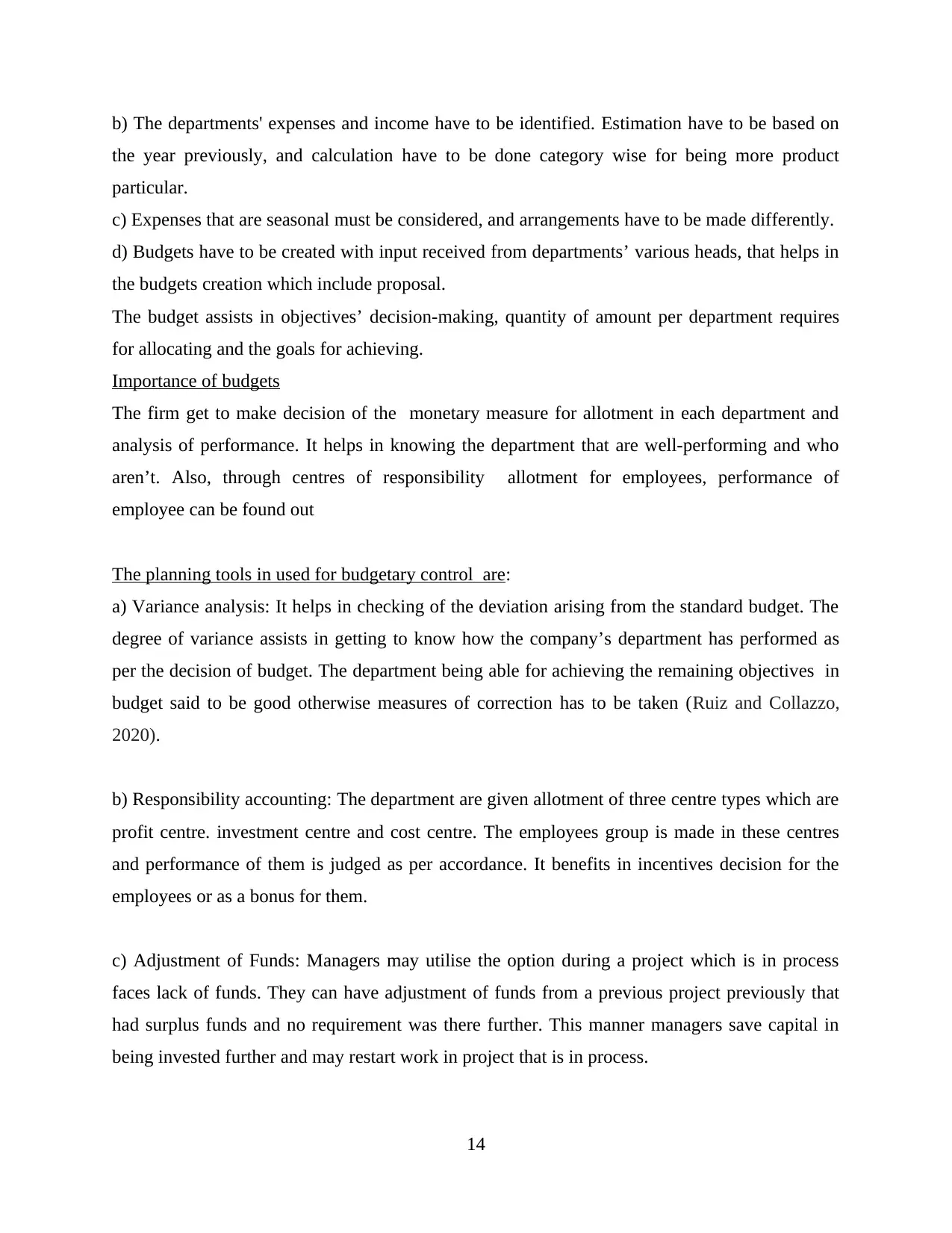
b) The departments' expenses and income have to be identified. Estimation have to be based on
the year previously, and calculation have to be done category wise for being more product
particular.
c) Expenses that are seasonal must be considered, and arrangements have to be made differently.
d) Budgets have to be created with input received from departments’ various heads, that helps in
the budgets creation which include proposal.
The budget assists in objectives’ decision-making, quantity of amount per department requires
for allocating and the goals for achieving.
Importance of budgets
The firm get to make decision of the monetary measure for allotment in each department and
analysis of performance. It helps in knowing the department that are well-performing and who
aren’t. Also, through centres of responsibility allotment for employees, performance of
employee can be found out
The planning tools in used for budgetary control are:
a) Variance analysis: It helps in checking of the deviation arising from the standard budget. The
degree of variance assists in getting to know how the company’s department has performed as
per the decision of budget. The department being able for achieving the remaining objectives in
budget said to be good otherwise measures of correction has to be taken (Ruiz and Collazzo,
2020).
b) Responsibility accounting: The department are given allotment of three centre types which are
profit centre. investment centre and cost centre. The employees group is made in these centres
and performance of them is judged as per accordance. It benefits in incentives decision for the
employees or as a bonus for them.
c) Adjustment of Funds: Managers may utilise the option during a project which is in process
faces lack of funds. They can have adjustment of funds from a previous project previously that
had surplus funds and no requirement was there further. This manner managers save capital in
being invested further and may restart work in project that is in process.
14
the year previously, and calculation have to be done category wise for being more product
particular.
c) Expenses that are seasonal must be considered, and arrangements have to be made differently.
d) Budgets have to be created with input received from departments’ various heads, that helps in
the budgets creation which include proposal.
The budget assists in objectives’ decision-making, quantity of amount per department requires
for allocating and the goals for achieving.
Importance of budgets
The firm get to make decision of the monetary measure for allotment in each department and
analysis of performance. It helps in knowing the department that are well-performing and who
aren’t. Also, through centres of responsibility allotment for employees, performance of
employee can be found out
The planning tools in used for budgetary control are:
a) Variance analysis: It helps in checking of the deviation arising from the standard budget. The
degree of variance assists in getting to know how the company’s department has performed as
per the decision of budget. The department being able for achieving the remaining objectives in
budget said to be good otherwise measures of correction has to be taken (Ruiz and Collazzo,
2020).
b) Responsibility accounting: The department are given allotment of three centre types which are
profit centre. investment centre and cost centre. The employees group is made in these centres
and performance of them is judged as per accordance. It benefits in incentives decision for the
employees or as a bonus for them.
c) Adjustment of Funds: Managers may utilise the option during a project which is in process
faces lack of funds. They can have adjustment of funds from a previous project previously that
had surplus funds and no requirement was there further. This manner managers save capital in
being invested further and may restart work in project that is in process.
14
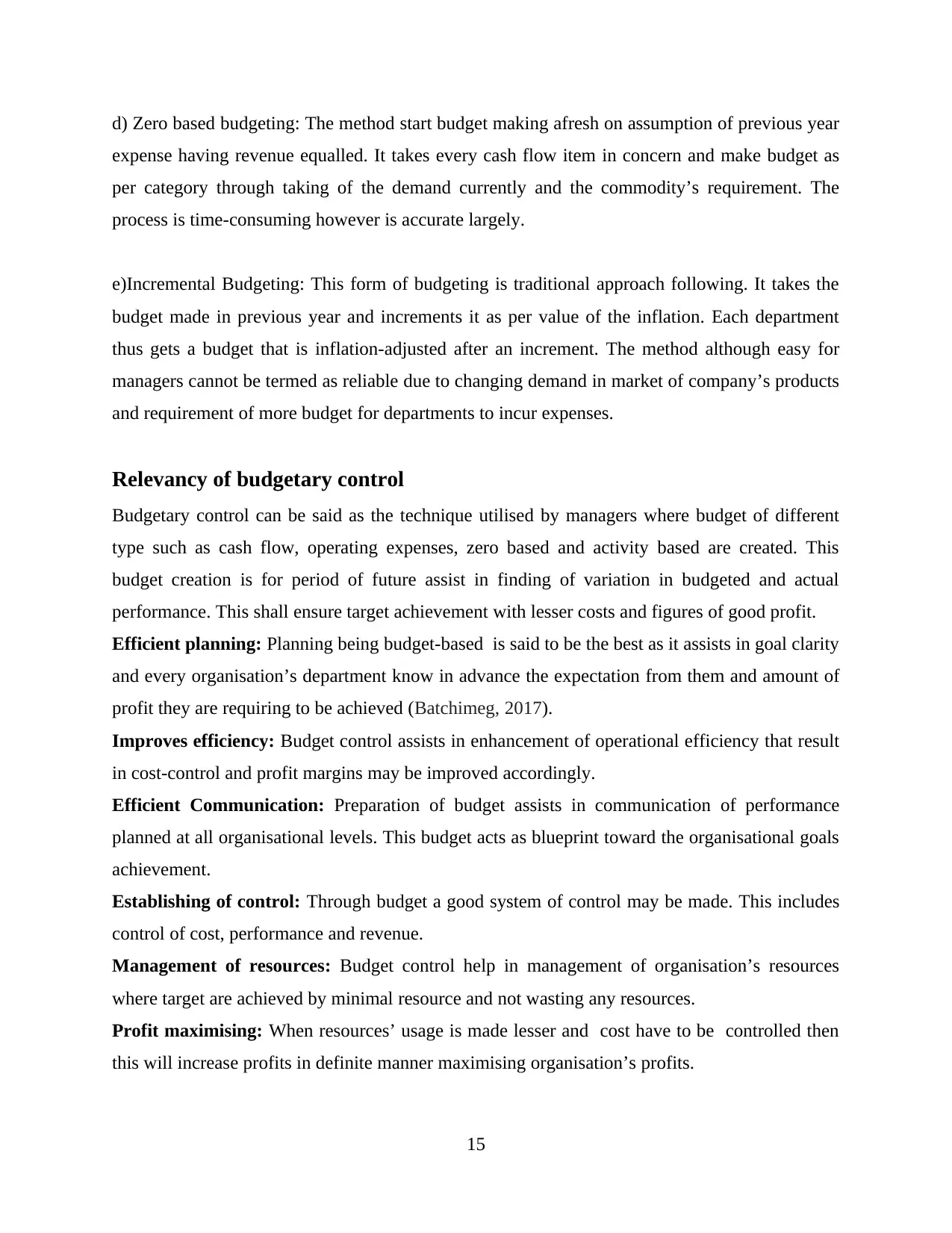
d) Zero based budgeting: The method start budget making afresh on assumption of previous year
expense having revenue equalled. It takes every cash flow item in concern and make budget as
per category through taking of the demand currently and the commodity’s requirement. The
process is time-consuming however is accurate largely.
e)Incremental Budgeting: This form of budgeting is traditional approach following. It takes the
budget made in previous year and increments it as per value of the inflation. Each department
thus gets a budget that is inflation-adjusted after an increment. The method although easy for
managers cannot be termed as reliable due to changing demand in market of company’s products
and requirement of more budget for departments to incur expenses.
Relevancy of budgetary control
Budgetary control can be said as the technique utilised by managers where budget of different
type such as cash flow, operating expenses, zero based and activity based are created. This
budget creation is for period of future assist in finding of variation in budgeted and actual
performance. This shall ensure target achievement with lesser costs and figures of good profit.
Efficient planning: Planning being budget-based is said to be the best as it assists in goal clarity
and every organisation’s department know in advance the expectation from them and amount of
profit they are requiring to be achieved (Batchimeg, 2017).
Improves efficiency: Budget control assists in enhancement of operational efficiency that result
in cost-control and profit margins may be improved accordingly.
Efficient Communication: Preparation of budget assists in communication of performance
planned at all organisational levels. This budget acts as blueprint toward the organisational goals
achievement.
Establishing of control: Through budget a good system of control may be made. This includes
control of cost, performance and revenue.
Management of resources: Budget control help in management of organisation’s resources
where target are achieved by minimal resource and not wasting any resources.
Profit maximising: When resources’ usage is made lesser and cost have to be controlled then
this will increase profits in definite manner maximising organisation’s profits.
15
expense having revenue equalled. It takes every cash flow item in concern and make budget as
per category through taking of the demand currently and the commodity’s requirement. The
process is time-consuming however is accurate largely.
e)Incremental Budgeting: This form of budgeting is traditional approach following. It takes the
budget made in previous year and increments it as per value of the inflation. Each department
thus gets a budget that is inflation-adjusted after an increment. The method although easy for
managers cannot be termed as reliable due to changing demand in market of company’s products
and requirement of more budget for departments to incur expenses.
Relevancy of budgetary control
Budgetary control can be said as the technique utilised by managers where budget of different
type such as cash flow, operating expenses, zero based and activity based are created. This
budget creation is for period of future assist in finding of variation in budgeted and actual
performance. This shall ensure target achievement with lesser costs and figures of good profit.
Efficient planning: Planning being budget-based is said to be the best as it assists in goal clarity
and every organisation’s department know in advance the expectation from them and amount of
profit they are requiring to be achieved (Batchimeg, 2017).
Improves efficiency: Budget control assists in enhancement of operational efficiency that result
in cost-control and profit margins may be improved accordingly.
Efficient Communication: Preparation of budget assists in communication of performance
planned at all organisational levels. This budget acts as blueprint toward the organisational goals
achievement.
Establishing of control: Through budget a good system of control may be made. This includes
control of cost, performance and revenue.
Management of resources: Budget control help in management of organisation’s resources
where target are achieved by minimal resource and not wasting any resources.
Profit maximising: When resources’ usage is made lesser and cost have to be controlled then
this will increase profits in definite manner maximising organisation’s profits.
15
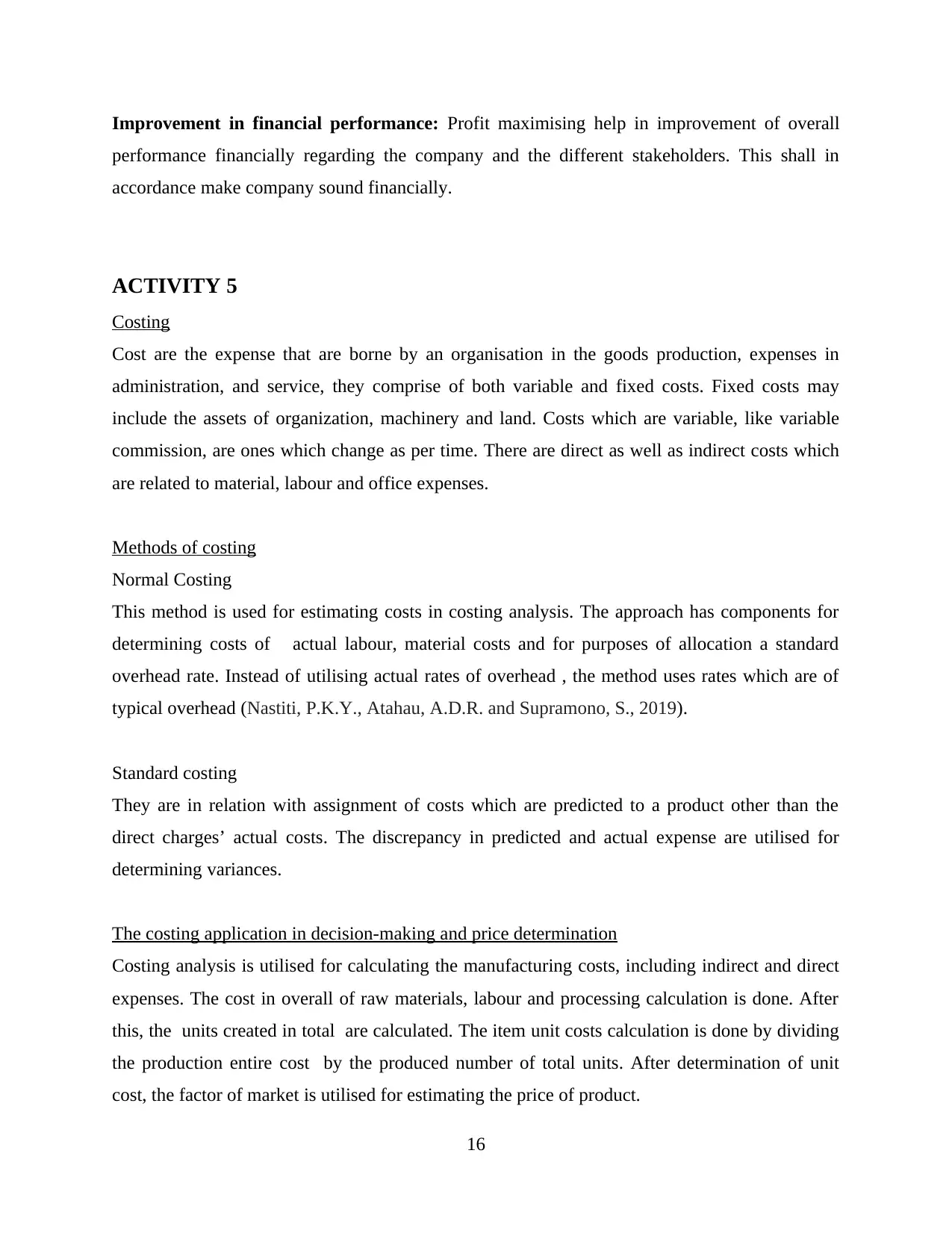
Improvement in financial performance: Profit maximising help in improvement of overall
performance financially regarding the company and the different stakeholders. This shall in
accordance make company sound financially.
ACTIVITY 5
Costing
Cost are the expense that are borne by an organisation in the goods production, expenses in
administration, and service, they comprise of both variable and fixed costs. Fixed costs may
include the assets of organization, machinery and land. Costs which are variable, like variable
commission, are ones which change as per time. There are direct as well as indirect costs which
are related to material, labour and office expenses.
Methods of costing
Normal Costing
This method is used for estimating costs in costing analysis. The approach has components for
determining costs of actual labour, material costs and for purposes of allocation a standard
overhead rate. Instead of utilising actual rates of overhead , the method uses rates which are of
typical overhead (Nastiti, P.K.Y., Atahau, A.D.R. and Supramono, S., 2019).
Standard costing
They are in relation with assignment of costs which are predicted to a product other than the
direct charges’ actual costs. The discrepancy in predicted and actual expense are utilised for
determining variances.
The costing application in decision-making and price determination
Costing analysis is utilised for calculating the manufacturing costs, including indirect and direct
expenses. The cost in overall of raw materials, labour and processing calculation is done. After
this, the units created in total are calculated. The item unit costs calculation is done by dividing
the production entire cost by the produced number of total units. After determination of unit
cost, the factor of market is utilised for estimating the price of product.
16
performance financially regarding the company and the different stakeholders. This shall in
accordance make company sound financially.
ACTIVITY 5
Costing
Cost are the expense that are borne by an organisation in the goods production, expenses in
administration, and service, they comprise of both variable and fixed costs. Fixed costs may
include the assets of organization, machinery and land. Costs which are variable, like variable
commission, are ones which change as per time. There are direct as well as indirect costs which
are related to material, labour and office expenses.
Methods of costing
Normal Costing
This method is used for estimating costs in costing analysis. The approach has components for
determining costs of actual labour, material costs and for purposes of allocation a standard
overhead rate. Instead of utilising actual rates of overhead , the method uses rates which are of
typical overhead (Nastiti, P.K.Y., Atahau, A.D.R. and Supramono, S., 2019).
Standard costing
They are in relation with assignment of costs which are predicted to a product other than the
direct charges’ actual costs. The discrepancy in predicted and actual expense are utilised for
determining variances.
The costing application in decision-making and price determination
Costing analysis is utilised for calculating the manufacturing costs, including indirect and direct
expenses. The cost in overall of raw materials, labour and processing calculation is done. After
this, the units created in total are calculated. The item unit costs calculation is done by dividing
the production entire cost by the produced number of total units. After determination of unit
cost, the factor of market is utilised for estimating the price of product.
16
Paraphrase This Document
Need a fresh take? Get an instant paraphrase of this document with our AI Paraphraser
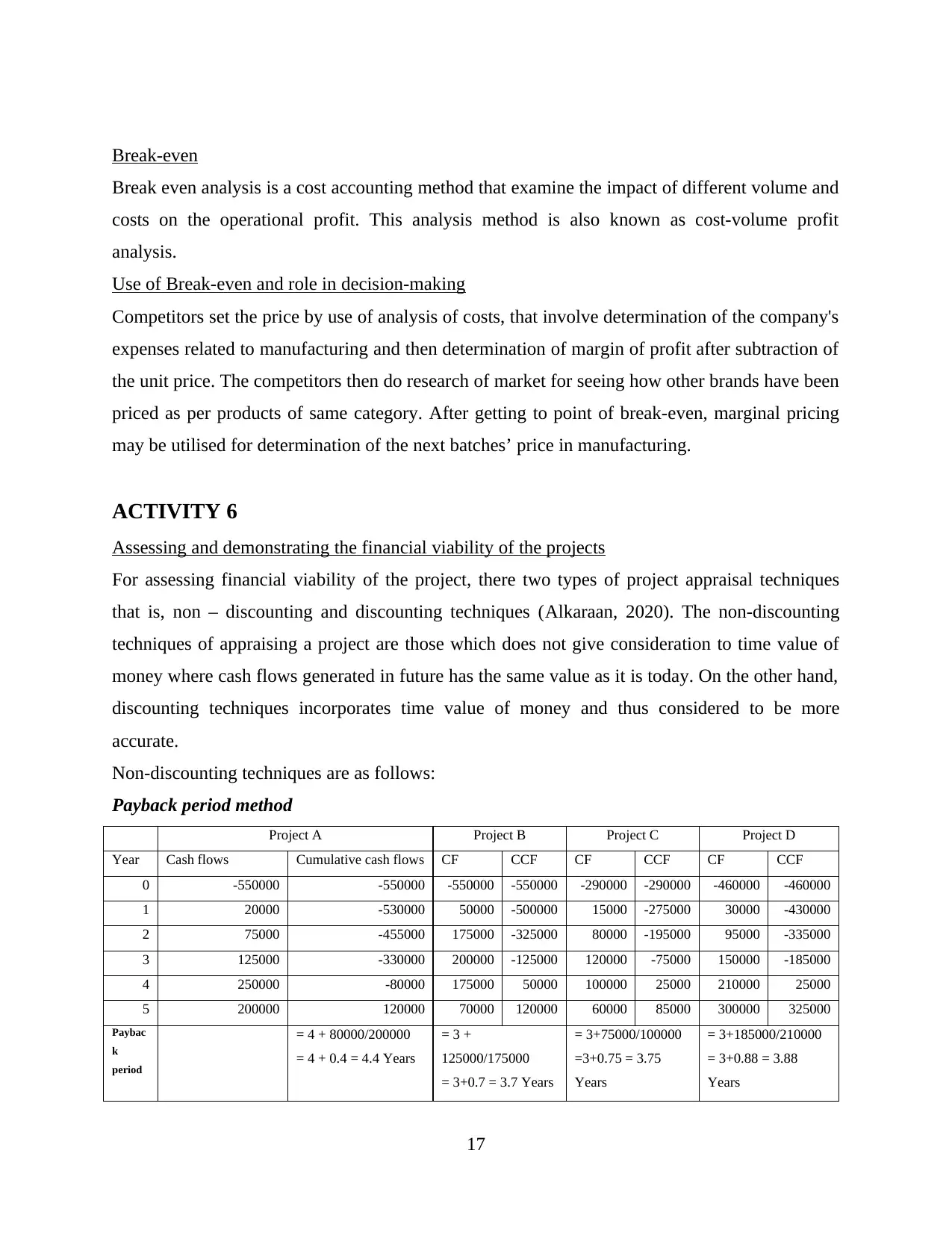
Break-even
Break even analysis is a cost accounting method that examine the impact of different volume and
costs on the operational profit. This analysis method is also known as cost-volume profit
analysis.
Use of Break-even and role in decision-making
Competitors set the price by use of analysis of costs, that involve determination of the company's
expenses related to manufacturing and then determination of margin of profit after subtraction of
the unit price. The competitors then do research of market for seeing how other brands have been
priced as per products of same category. After getting to point of break-even, marginal pricing
may be utilised for determination of the next batches’ price in manufacturing.
ACTIVITY 6
Assessing and demonstrating the financial viability of the projects
For assessing financial viability of the project, there two types of project appraisal techniques
that is, non – discounting and discounting techniques (Alkaraan, 2020). The non-discounting
techniques of appraising a project are those which does not give consideration to time value of
money where cash flows generated in future has the same value as it is today. On the other hand,
discounting techniques incorporates time value of money and thus considered to be more
accurate.
Non-discounting techniques are as follows:
Payback period method
Project A Project B Project C Project D
Year Cash flows Cumulative cash flows CF CCF CF CCF CF CCF
0 -550000 -550000 -550000 -550000 -290000 -290000 -460000 -460000
1 20000 -530000 50000 -500000 15000 -275000 30000 -430000
2 75000 -455000 175000 -325000 80000 -195000 95000 -335000
3 125000 -330000 200000 -125000 120000 -75000 150000 -185000
4 250000 -80000 175000 50000 100000 25000 210000 25000
5 200000 120000 70000 120000 60000 85000 300000 325000
Paybac
k
period
= 4 + 80000/200000
= 4 + 0.4 = 4.4 Years
= 3 +
125000/175000
= 3+0.7 = 3.7 Years
= 3+75000/100000
=3+0.75 = 3.75
Years
= 3+185000/210000
= 3+0.88 = 3.88
Years
17
Break even analysis is a cost accounting method that examine the impact of different volume and
costs on the operational profit. This analysis method is also known as cost-volume profit
analysis.
Use of Break-even and role in decision-making
Competitors set the price by use of analysis of costs, that involve determination of the company's
expenses related to manufacturing and then determination of margin of profit after subtraction of
the unit price. The competitors then do research of market for seeing how other brands have been
priced as per products of same category. After getting to point of break-even, marginal pricing
may be utilised for determination of the next batches’ price in manufacturing.
ACTIVITY 6
Assessing and demonstrating the financial viability of the projects
For assessing financial viability of the project, there two types of project appraisal techniques
that is, non – discounting and discounting techniques (Alkaraan, 2020). The non-discounting
techniques of appraising a project are those which does not give consideration to time value of
money where cash flows generated in future has the same value as it is today. On the other hand,
discounting techniques incorporates time value of money and thus considered to be more
accurate.
Non-discounting techniques are as follows:
Payback period method
Project A Project B Project C Project D
Year Cash flows Cumulative cash flows CF CCF CF CCF CF CCF
0 -550000 -550000 -550000 -550000 -290000 -290000 -460000 -460000
1 20000 -530000 50000 -500000 15000 -275000 30000 -430000
2 75000 -455000 175000 -325000 80000 -195000 95000 -335000
3 125000 -330000 200000 -125000 120000 -75000 150000 -185000
4 250000 -80000 175000 50000 100000 25000 210000 25000
5 200000 120000 70000 120000 60000 85000 300000 325000
Paybac
k
period
= 4 + 80000/200000
= 4 + 0.4 = 4.4 Years
= 3 +
125000/175000
= 3+0.7 = 3.7 Years
= 3+75000/100000
=3+0.75 = 3.75
Years
= 3+185000/210000
= 3+0.88 = 3.88
Years
17

Accounting rate of return
Project A Project B Project C Project D
Year Cash flows/Profits
1 20000 50000 15000 30000
2 75000 175000 80000 95000
3 125000 200000 120000 150000
4 250000 175000 100000 210000
5 200000 70000 60000 300000
Total profit 670000 670000 375000 785000
Average Profit (a) 134000 134000 75000 157000
Initial Investment (b) 550000 550000 290000 460000
ARR = a / b 24% 24% 26% 34%
Discounting techniques are as follows:
Net Present Value
Yea
r
Project
A
Discounting
Factor (DF)
@4.5%
PV of CF Project B DF
@
5%
PV of CF Project C DF
@
5.5%
PV of
CF
Project
D
DF
@
6%
PV of
CF
0 -550000 1 -550000 -550000 1 -550000 -290000 1 -290000 -460000 1 -460000
1 20000 0.957 19140 50000 0.952 47600 15000 0.948 14220 30000 0.943 28290
2 75000 0.916 68700 175000 0.907 158725 80000 0.898 71840 95000 0.89 84550
3 125000 0.876 109500 200000 0.864 172800 120000 0.852 102240 150000 0.839 125850
4 250000 0.838 209500 175000 0.823 144025 100000 0.807 80700 210000 0.792 166320
5 200000 0.802 160400 70000 0.783 54810 60000 0.765 45900 300000 0.747 224100
NP
V
17240 27960 24900 169110
Internal Rate of Return
Year 0 1 2 3 4 5 IRR
Project A -550000 20000 75000 125000 250000 200000 5%
Project B -550000 50000 175000 200000 175000 70000 7%
Project C -290000 15000 80000 120000 100000 60000 8%
Project D -460000 30000 95000 150000 210000 300000 15%
18
Project A Project B Project C Project D
Year Cash flows/Profits
1 20000 50000 15000 30000
2 75000 175000 80000 95000
3 125000 200000 120000 150000
4 250000 175000 100000 210000
5 200000 70000 60000 300000
Total profit 670000 670000 375000 785000
Average Profit (a) 134000 134000 75000 157000
Initial Investment (b) 550000 550000 290000 460000
ARR = a / b 24% 24% 26% 34%
Discounting techniques are as follows:
Net Present Value
Yea
r
Project
A
Discounting
Factor (DF)
@4.5%
PV of CF Project B DF
@
5%
PV of CF Project C DF
@
5.5%
PV of
CF
Project
D
DF
@
6%
PV of
CF
0 -550000 1 -550000 -550000 1 -550000 -290000 1 -290000 -460000 1 -460000
1 20000 0.957 19140 50000 0.952 47600 15000 0.948 14220 30000 0.943 28290
2 75000 0.916 68700 175000 0.907 158725 80000 0.898 71840 95000 0.89 84550
3 125000 0.876 109500 200000 0.864 172800 120000 0.852 102240 150000 0.839 125850
4 250000 0.838 209500 175000 0.823 144025 100000 0.807 80700 210000 0.792 166320
5 200000 0.802 160400 70000 0.783 54810 60000 0.765 45900 300000 0.747 224100
NP
V
17240 27960 24900 169110
Internal Rate of Return
Year 0 1 2 3 4 5 IRR
Project A -550000 20000 75000 125000 250000 200000 5%
Project B -550000 50000 175000 200000 175000 70000 7%
Project C -290000 15000 80000 120000 100000 60000 8%
Project D -460000 30000 95000 150000 210000 300000 15%
18
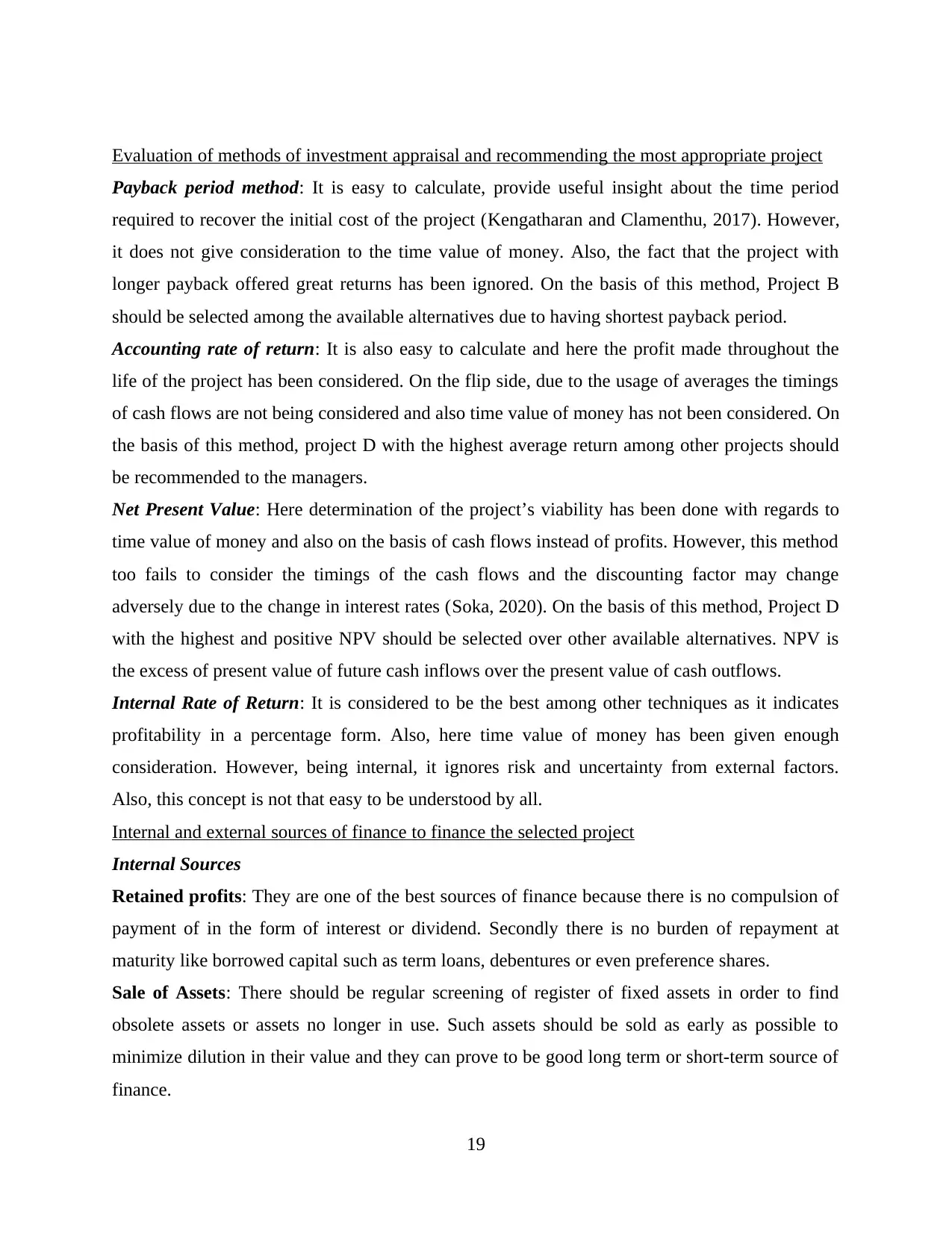
Evaluation of methods of investment appraisal and recommending the most appropriate project
Payback period method: It is easy to calculate, provide useful insight about the time period
required to recover the initial cost of the project (Kengatharan and Clamenthu, 2017). However,
it does not give consideration to the time value of money. Also, the fact that the project with
longer payback offered great returns has been ignored. On the basis of this method, Project B
should be selected among the available alternatives due to having shortest payback period.
Accounting rate of return: It is also easy to calculate and here the profit made throughout the
life of the project has been considered. On the flip side, due to the usage of averages the timings
of cash flows are not being considered and also time value of money has not been considered. On
the basis of this method, project D with the highest average return among other projects should
be recommended to the managers.
Net Present Value: Here determination of the project’s viability has been done with regards to
time value of money and also on the basis of cash flows instead of profits. However, this method
too fails to consider the timings of the cash flows and the discounting factor may change
adversely due to the change in interest rates (Soka, 2020). On the basis of this method, Project D
with the highest and positive NPV should be selected over other available alternatives. NPV is
the excess of present value of future cash inflows over the present value of cash outflows.
Internal Rate of Return: It is considered to be the best among other techniques as it indicates
profitability in a percentage form. Also, here time value of money has been given enough
consideration. However, being internal, it ignores risk and uncertainty from external factors.
Also, this concept is not that easy to be understood by all.
Internal and external sources of finance to finance the selected project
Internal Sources
Retained profits: They are one of the best sources of finance because there is no compulsion of
payment of in the form of interest or dividend. Secondly there is no burden of repayment at
maturity like borrowed capital such as term loans, debentures or even preference shares.
Sale of Assets: There should be regular screening of register of fixed assets in order to find
obsolete assets or assets no longer in use. Such assets should be sold as early as possible to
minimize dilution in their value and they can prove to be good long term or short-term source of
finance.
19
Payback period method: It is easy to calculate, provide useful insight about the time period
required to recover the initial cost of the project (Kengatharan and Clamenthu, 2017). However,
it does not give consideration to the time value of money. Also, the fact that the project with
longer payback offered great returns has been ignored. On the basis of this method, Project B
should be selected among the available alternatives due to having shortest payback period.
Accounting rate of return: It is also easy to calculate and here the profit made throughout the
life of the project has been considered. On the flip side, due to the usage of averages the timings
of cash flows are not being considered and also time value of money has not been considered. On
the basis of this method, project D with the highest average return among other projects should
be recommended to the managers.
Net Present Value: Here determination of the project’s viability has been done with regards to
time value of money and also on the basis of cash flows instead of profits. However, this method
too fails to consider the timings of the cash flows and the discounting factor may change
adversely due to the change in interest rates (Soka, 2020). On the basis of this method, Project D
with the highest and positive NPV should be selected over other available alternatives. NPV is
the excess of present value of future cash inflows over the present value of cash outflows.
Internal Rate of Return: It is considered to be the best among other techniques as it indicates
profitability in a percentage form. Also, here time value of money has been given enough
consideration. However, being internal, it ignores risk and uncertainty from external factors.
Also, this concept is not that easy to be understood by all.
Internal and external sources of finance to finance the selected project
Internal Sources
Retained profits: They are one of the best sources of finance because there is no compulsion of
payment of in the form of interest or dividend. Secondly there is no burden of repayment at
maturity like borrowed capital such as term loans, debentures or even preference shares.
Sale of Assets: There should be regular screening of register of fixed assets in order to find
obsolete assets or assets no longer in use. Such assets should be sold as early as possible to
minimize dilution in their value and they can prove to be good long term or short-term source of
finance.
19
Secure Best Marks with AI Grader
Need help grading? Try our AI Grader for instant feedback on your assignments.
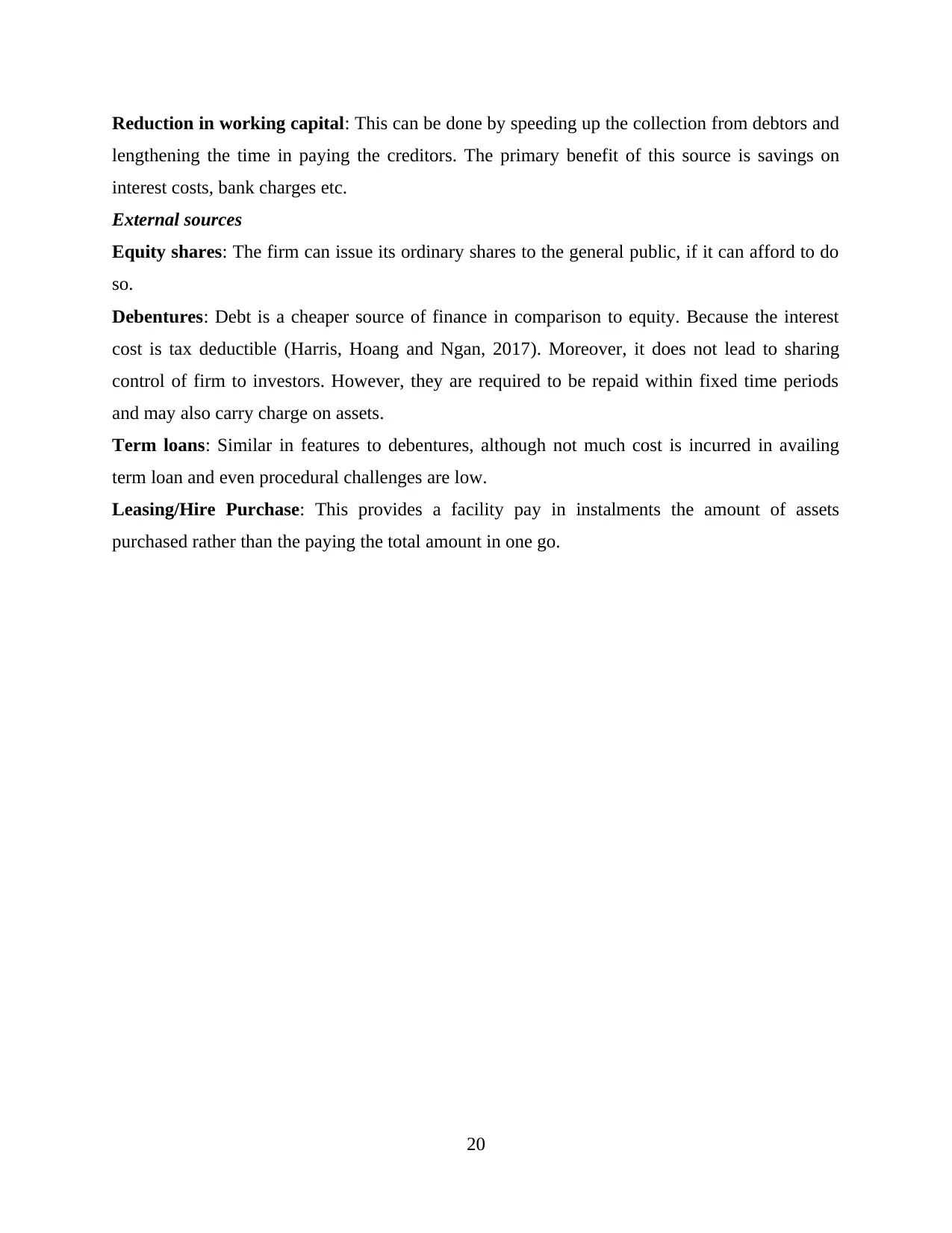
Reduction in working capital: This can be done by speeding up the collection from debtors and
lengthening the time in paying the creditors. The primary benefit of this source is savings on
interest costs, bank charges etc.
External sources
Equity shares: The firm can issue its ordinary shares to the general public, if it can afford to do
so.
Debentures: Debt is a cheaper source of finance in comparison to equity. Because the interest
cost is tax deductible (Harris, Hoang and Ngan, 2017). Moreover, it does not lead to sharing
control of firm to investors. However, they are required to be repaid within fixed time periods
and may also carry charge on assets.
Term loans: Similar in features to debentures, although not much cost is incurred in availing
term loan and even procedural challenges are low.
Leasing/Hire Purchase: This provides a facility pay in instalments the amount of assets
purchased rather than the paying the total amount in one go.
20
lengthening the time in paying the creditors. The primary benefit of this source is savings on
interest costs, bank charges etc.
External sources
Equity shares: The firm can issue its ordinary shares to the general public, if it can afford to do
so.
Debentures: Debt is a cheaper source of finance in comparison to equity. Because the interest
cost is tax deductible (Harris, Hoang and Ngan, 2017). Moreover, it does not lead to sharing
control of firm to investors. However, they are required to be repaid within fixed time periods
and may also carry charge on assets.
Term loans: Similar in features to debentures, although not much cost is incurred in availing
term loan and even procedural challenges are low.
Leasing/Hire Purchase: This provides a facility pay in instalments the amount of assets
purchased rather than the paying the total amount in one go.
20

CONCLUSION
It can be concluded that finance is a vast subject for evaluation. The report said about the
importance and purpose of meeting the requirements according to the stakeholders. The
requirement of financial organization for maintaining the financial records was discussed. Legal
and organizational requirements of the organization was discussed. Components of working
capital was discussed through ratio analysis of competitor. Ways of managing the working
capital was discussed for organization. The difference between financial and management
accounting was explained. Budgetary control process was analyzed. Evaluation of costing
techniques used for pricing purposes was done. Appraisal techniques for investment were talked
about along with recommendations. Internal and external finance sources were explained.
21
It can be concluded that finance is a vast subject for evaluation. The report said about the
importance and purpose of meeting the requirements according to the stakeholders. The
requirement of financial organization for maintaining the financial records was discussed. Legal
and organizational requirements of the organization was discussed. Components of working
capital was discussed through ratio analysis of competitor. Ways of managing the working
capital was discussed for organization. The difference between financial and management
accounting was explained. Budgetary control process was analyzed. Evaluation of costing
techniques used for pricing purposes was done. Appraisal techniques for investment were talked
about along with recommendations. Internal and external finance sources were explained.
21
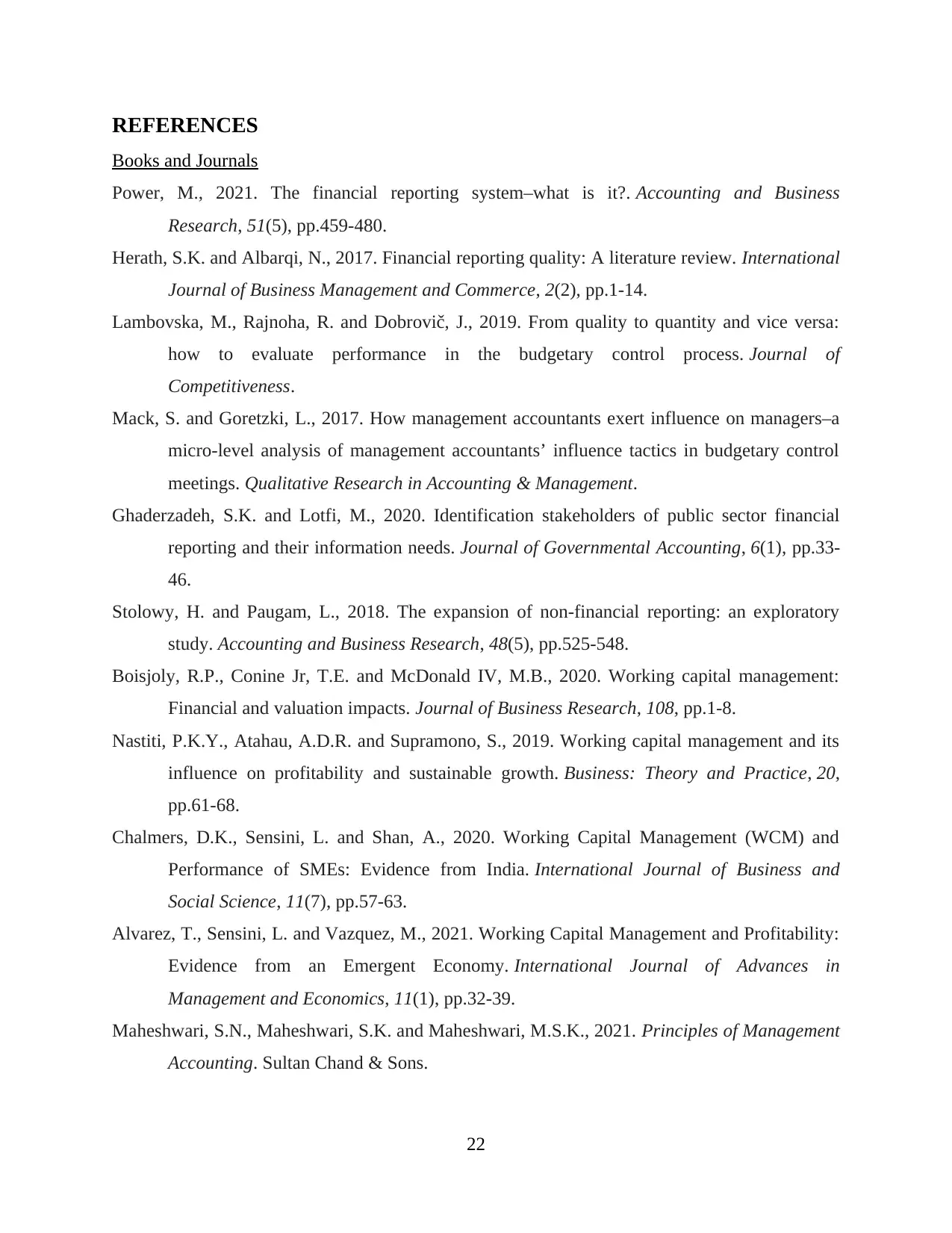
REFERENCES
Books and Journals
Power, M., 2021. The financial reporting system–what is it?. Accounting and Business
Research, 51(5), pp.459-480.
Herath, S.K. and Albarqi, N., 2017. Financial reporting quality: A literature review. International
Journal of Business Management and Commerce, 2(2), pp.1-14.
Lambovska, M., Rajnoha, R. and Dobrovič, J., 2019. From quality to quantity and vice versa:
how to evaluate performance in the budgetary control process. Journal of
Competitiveness.
Mack, S. and Goretzki, L., 2017. How management accountants exert influence on managers–a
micro-level analysis of management accountants’ influence tactics in budgetary control
meetings. Qualitative Research in Accounting & Management.
Ghaderzadeh, S.K. and Lotfi, M., 2020. Identification stakeholders of public sector financial
reporting and their information needs. Journal of Governmental Accounting, 6(1), pp.33-
46.
Stolowy, H. and Paugam, L., 2018. The expansion of non-financial reporting: an exploratory
study. Accounting and Business Research, 48(5), pp.525-548.
Boisjoly, R.P., Conine Jr, T.E. and McDonald IV, M.B., 2020. Working capital management:
Financial and valuation impacts. Journal of Business Research, 108, pp.1-8.
Nastiti, P.K.Y., Atahau, A.D.R. and Supramono, S., 2019. Working capital management and its
influence on profitability and sustainable growth. Business: Theory and Practice, 20,
pp.61-68.
Chalmers, D.K., Sensini, L. and Shan, A., 2020. Working Capital Management (WCM) and
Performance of SMEs: Evidence from India. International Journal of Business and
Social Science, 11(7), pp.57-63.
Alvarez, T., Sensini, L. and Vazquez, M., 2021. Working Capital Management and Profitability:
Evidence from an Emergent Economy. International Journal of Advances in
Management and Economics, 11(1), pp.32-39.
Maheshwari, S.N., Maheshwari, S.K. and Maheshwari, M.S.K., 2021. Principles of Management
Accounting. Sultan Chand & Sons.
22
Books and Journals
Power, M., 2021. The financial reporting system–what is it?. Accounting and Business
Research, 51(5), pp.459-480.
Herath, S.K. and Albarqi, N., 2017. Financial reporting quality: A literature review. International
Journal of Business Management and Commerce, 2(2), pp.1-14.
Lambovska, M., Rajnoha, R. and Dobrovič, J., 2019. From quality to quantity and vice versa:
how to evaluate performance in the budgetary control process. Journal of
Competitiveness.
Mack, S. and Goretzki, L., 2017. How management accountants exert influence on managers–a
micro-level analysis of management accountants’ influence tactics in budgetary control
meetings. Qualitative Research in Accounting & Management.
Ghaderzadeh, S.K. and Lotfi, M., 2020. Identification stakeholders of public sector financial
reporting and their information needs. Journal of Governmental Accounting, 6(1), pp.33-
46.
Stolowy, H. and Paugam, L., 2018. The expansion of non-financial reporting: an exploratory
study. Accounting and Business Research, 48(5), pp.525-548.
Boisjoly, R.P., Conine Jr, T.E. and McDonald IV, M.B., 2020. Working capital management:
Financial and valuation impacts. Journal of Business Research, 108, pp.1-8.
Nastiti, P.K.Y., Atahau, A.D.R. and Supramono, S., 2019. Working capital management and its
influence on profitability and sustainable growth. Business: Theory and Practice, 20,
pp.61-68.
Chalmers, D.K., Sensini, L. and Shan, A., 2020. Working Capital Management (WCM) and
Performance of SMEs: Evidence from India. International Journal of Business and
Social Science, 11(7), pp.57-63.
Alvarez, T., Sensini, L. and Vazquez, M., 2021. Working Capital Management and Profitability:
Evidence from an Emergent Economy. International Journal of Advances in
Management and Economics, 11(1), pp.32-39.
Maheshwari, S.N., Maheshwari, S.K. and Maheshwari, M.S.K., 2021. Principles of Management
Accounting. Sultan Chand & Sons.
22
Paraphrase This Document
Need a fresh take? Get an instant paraphrase of this document with our AI Paraphraser
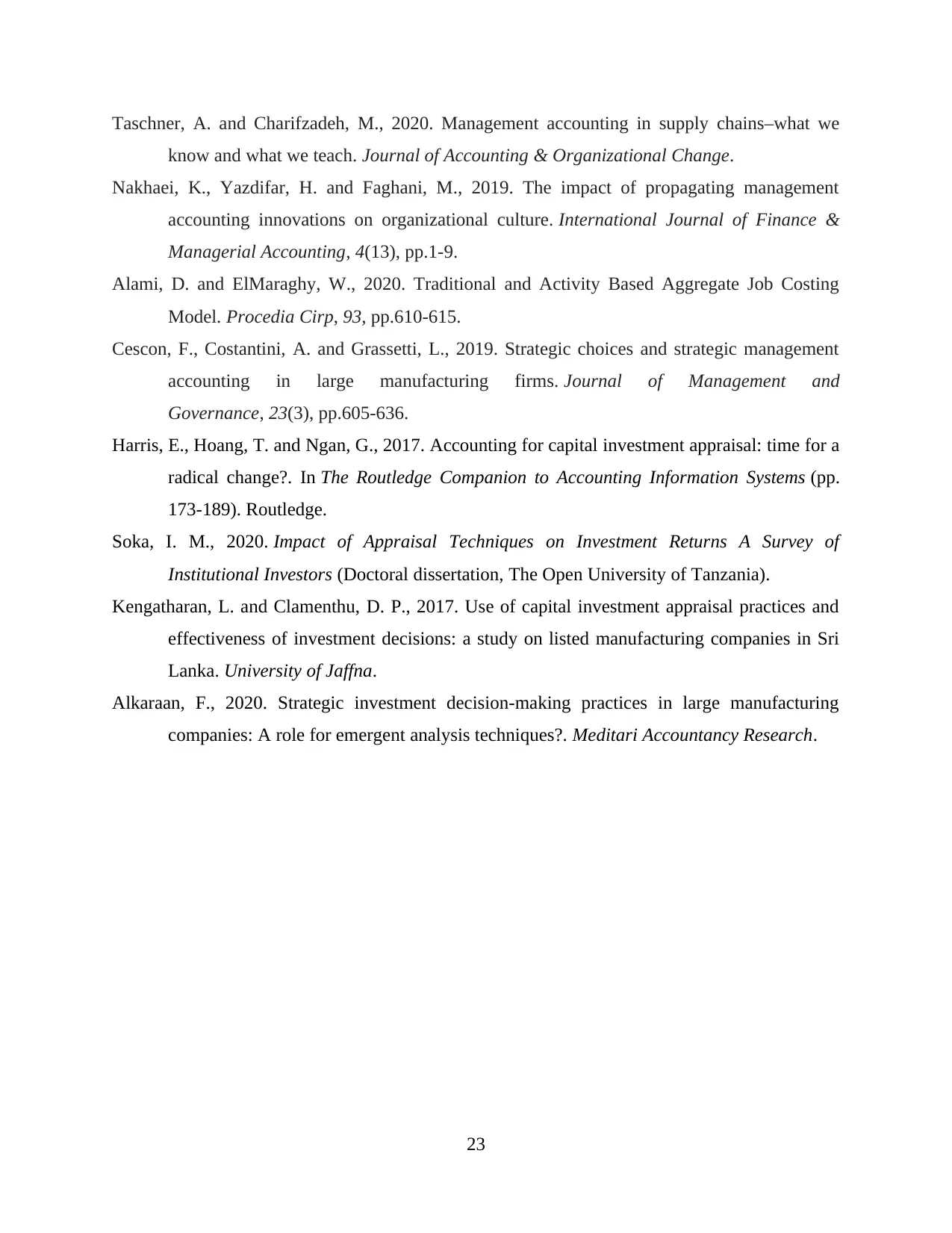
Taschner, A. and Charifzadeh, M., 2020. Management accounting in supply chains–what we
know and what we teach. Journal of Accounting & Organizational Change.
Nakhaei, K., Yazdifar, H. and Faghani, M., 2019. The impact of propagating management
accounting innovations on organizational culture. International Journal of Finance &
Managerial Accounting, 4(13), pp.1-9.
Alami, D. and ElMaraghy, W., 2020. Traditional and Activity Based Aggregate Job Costing
Model. Procedia Cirp, 93, pp.610-615.
Cescon, F., Costantini, A. and Grassetti, L., 2019. Strategic choices and strategic management
accounting in large manufacturing firms. Journal of Management and
Governance, 23(3), pp.605-636.
Harris, E., Hoang, T. and Ngan, G., 2017. Accounting for capital investment appraisal: time for a
radical change?. In The Routledge Companion to Accounting Information Systems (pp.
173-189). Routledge.
Soka, I. M., 2020. Impact of Appraisal Techniques on Investment Returns A Survey of
Institutional Investors (Doctoral dissertation, The Open University of Tanzania).
Kengatharan, L. and Clamenthu, D. P., 2017. Use of capital investment appraisal practices and
effectiveness of investment decisions: a study on listed manufacturing companies in Sri
Lanka. University of Jaffna.
Alkaraan, F., 2020. Strategic investment decision-making practices in large manufacturing
companies: A role for emergent analysis techniques?. Meditari Accountancy Research.
23
know and what we teach. Journal of Accounting & Organizational Change.
Nakhaei, K., Yazdifar, H. and Faghani, M., 2019. The impact of propagating management
accounting innovations on organizational culture. International Journal of Finance &
Managerial Accounting, 4(13), pp.1-9.
Alami, D. and ElMaraghy, W., 2020. Traditional and Activity Based Aggregate Job Costing
Model. Procedia Cirp, 93, pp.610-615.
Cescon, F., Costantini, A. and Grassetti, L., 2019. Strategic choices and strategic management
accounting in large manufacturing firms. Journal of Management and
Governance, 23(3), pp.605-636.
Harris, E., Hoang, T. and Ngan, G., 2017. Accounting for capital investment appraisal: time for a
radical change?. In The Routledge Companion to Accounting Information Systems (pp.
173-189). Routledge.
Soka, I. M., 2020. Impact of Appraisal Techniques on Investment Returns A Survey of
Institutional Investors (Doctoral dissertation, The Open University of Tanzania).
Kengatharan, L. and Clamenthu, D. P., 2017. Use of capital investment appraisal practices and
effectiveness of investment decisions: a study on listed manufacturing companies in Sri
Lanka. University of Jaffna.
Alkaraan, F., 2020. Strategic investment decision-making practices in large manufacturing
companies: A role for emergent analysis techniques?. Meditari Accountancy Research.
23
1 out of 23
Related Documents
Your All-in-One AI-Powered Toolkit for Academic Success.
+13062052269
info@desklib.com
Available 24*7 on WhatsApp / Email
![[object Object]](/_next/static/media/star-bottom.7253800d.svg)
Unlock your academic potential
© 2024 | Zucol Services PVT LTD | All rights reserved.





